61 Soft Curves in the Kitchen: Inspiring Ideas for a Functional and Flowing Space
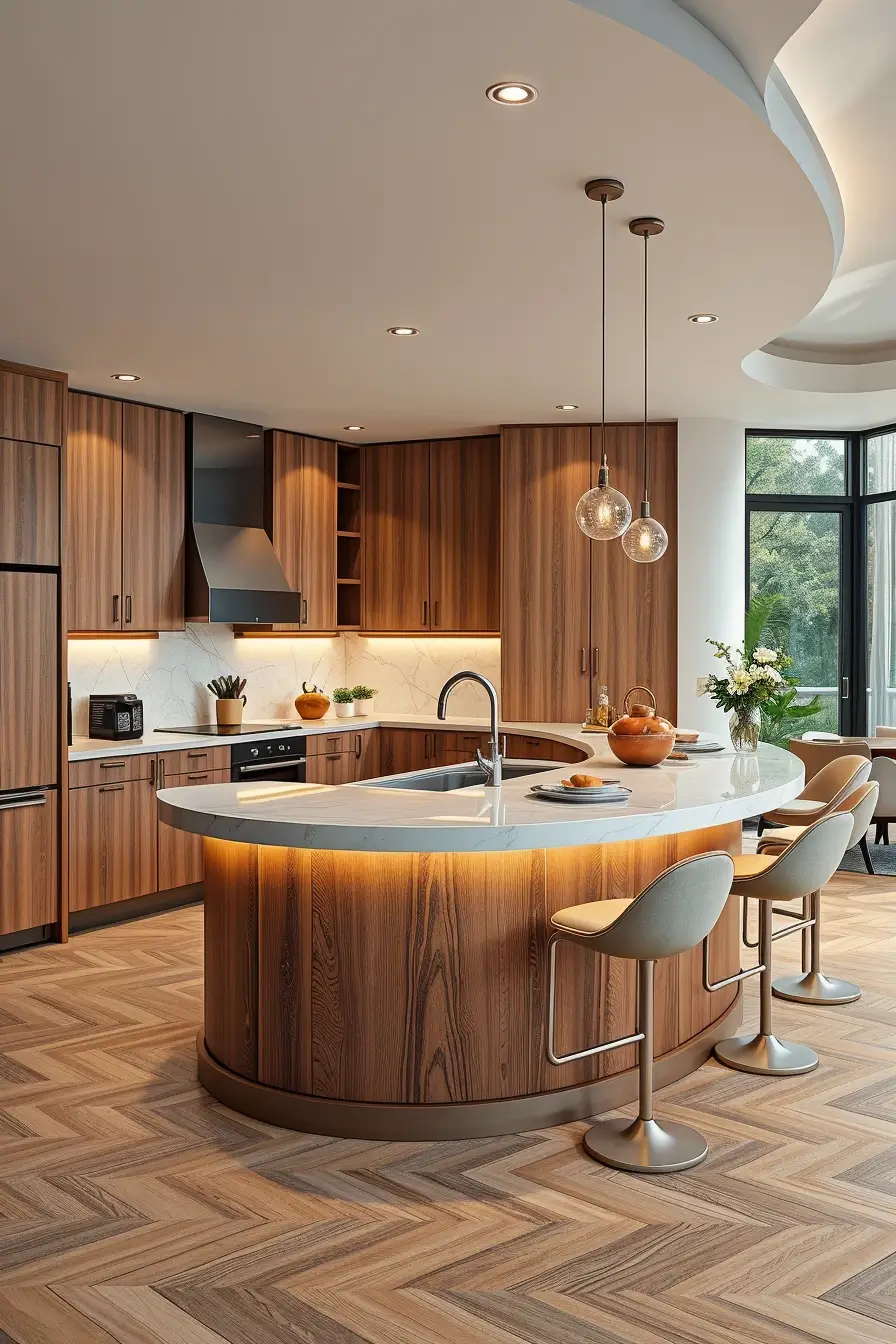
Curves in the kitchen are not just a trend of the eye, but a method of making the space feel fluid, inviting, and harmonious. What can the rounded form do to change how we cook, eat, and socialize? What is the reason why designers are adopting organic shapes in kitchen design? This article will discuss the soft curves of the kitchen movement, how it combines form and functionality and how it enhances both utility and beauty. Whether it is round countertops, carved islands, or slightly arched entryways, all these elements help to make the cooking environment friendlier.
The use of soft lines in the main components of the kitchen such as cabinetry, furniture, and lighting makes the kitchen a place that promotes the flow of movement and minimizes the severity of visual interruptions. I have personally experienced the way these features enhance spatial navigation as well as give a touch of elegance. In interviews, designers like Nate Berkus have observed that curved shapes are inherently guiding and make kitchens seem less cramped, a trick that applies just as well to small apartments as it does to large open-plan houses.
So, shall we explore all the possibilities of how we can use soft curves to make the kitchen a beautiful, harmonious place that will make people want to cook and talk?
Soft Curves In The Kitchen: Blending Function And Flow
My intention is to make the flow of the kitchen feel natural and intentional when I use soft curves in the kitchen. Curves enable a smooth transition between one thing and another, instead of the sudden angles that break sight lines. The style of design is especially useful in open-plan designs where the kitchen is in sight of the dining and living areas. I have found it minimizes visual clutter and creates a sense of movement without the severity of sharp edges.
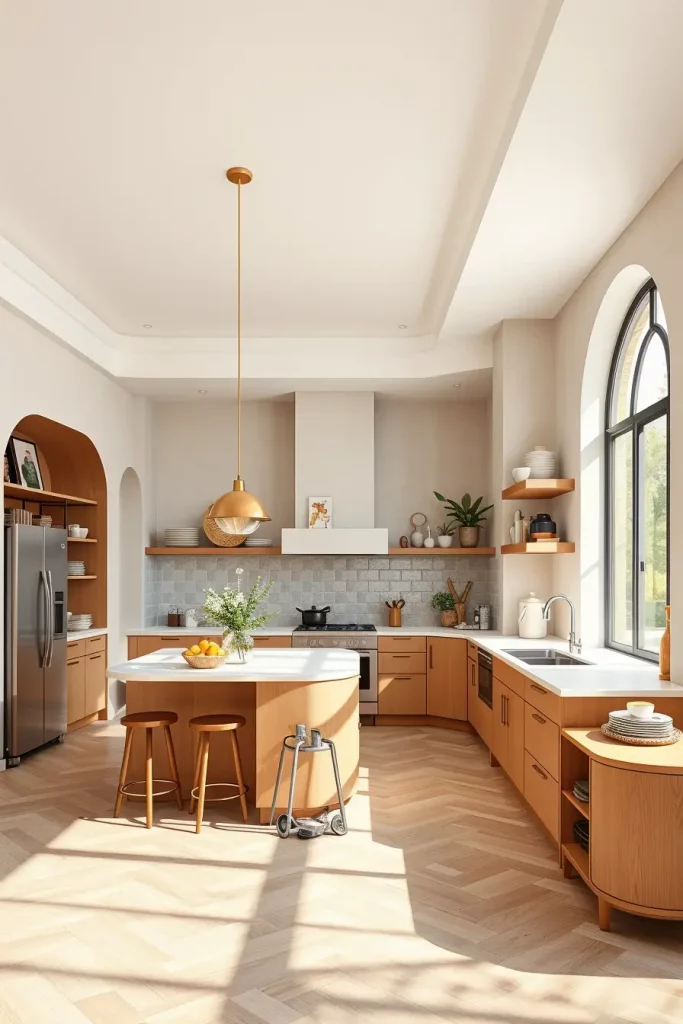
This smooth design is achieved through furniture and surfaces like rounded kitchen islands, oval tables and curved-edge countertops. It also helps to add curved cabinet handles or gently arched shelving to further the feeling of unity in the room. Such minor details as a rounded edge of the backsplash help unite the appearance.
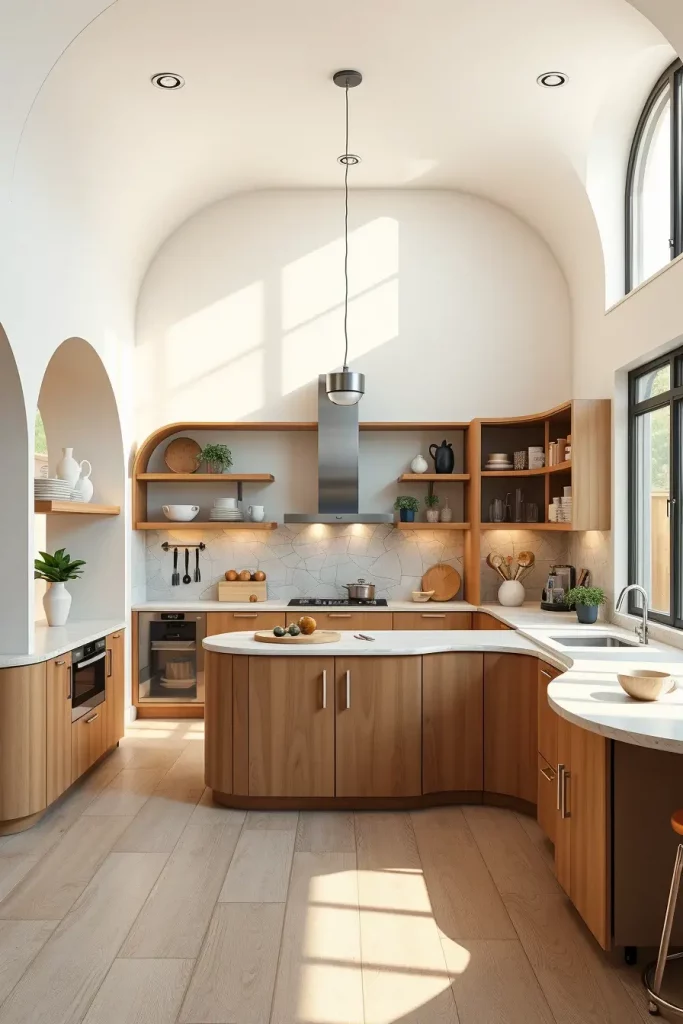
In my opinion, the most positive effect that the use of soft curves has is the way it enhances safety and comfort- particularly in busy kitchens where children are present. A rounded corner may imply less bruises and bumps and yet be fashionable.
The Allure Of Rounded Kitchen Islands
A curved kitchen design is centered on rounded kitchen islands. I frequently prescribe them, as they naturally become a point of convergence, and invite conversation and connection. The lack of sharp edges does not only appear softer but also allows moving around the island more easily, particularly in busy kitchens.
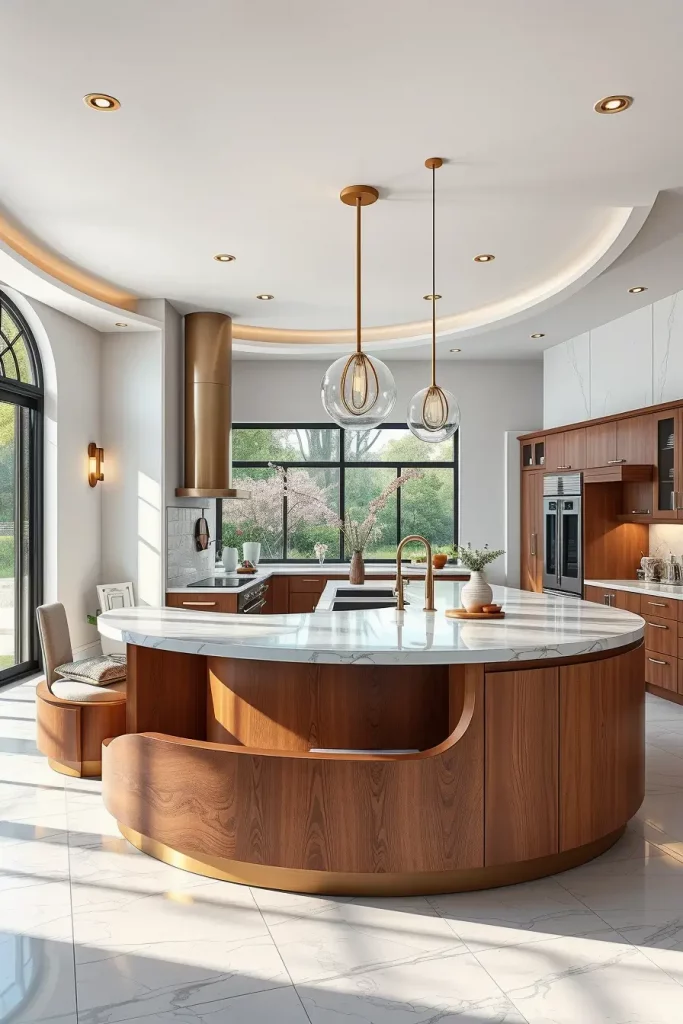
An island with rounded edges can be designed with built-in seating, prep sink or concealed storage, so it is a versatile focal point. I prefer to use it with a stone countertop, which reflects the same smooth curve of the base, and it is visually and practically balanced. The base may be covered with wood, tile or even curved metal to give it a smooth modern touch.
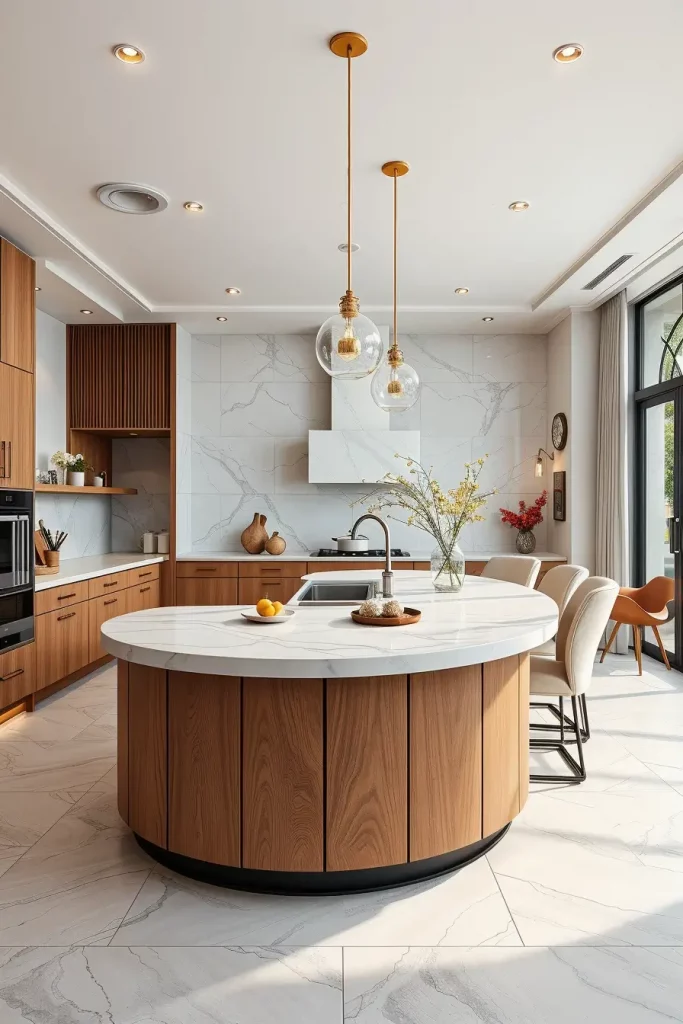
My personal experience has shown me the reaction of clients to rounded islands- they are approachable. Architectural Digest has noted them as one of the most long-lasting kitchen trends since they easily combine form with functionality.
Curved Countertops For Seamless Prep And Dining
Rounded countertops provide an elegant substitute to straight countertops. I tend to carry the curve of the countertop past the base cabinets in my projects to form a breakfast bar or more preparation space. This protrusion blurs the visual edges of the kitchen, making it friendlier.
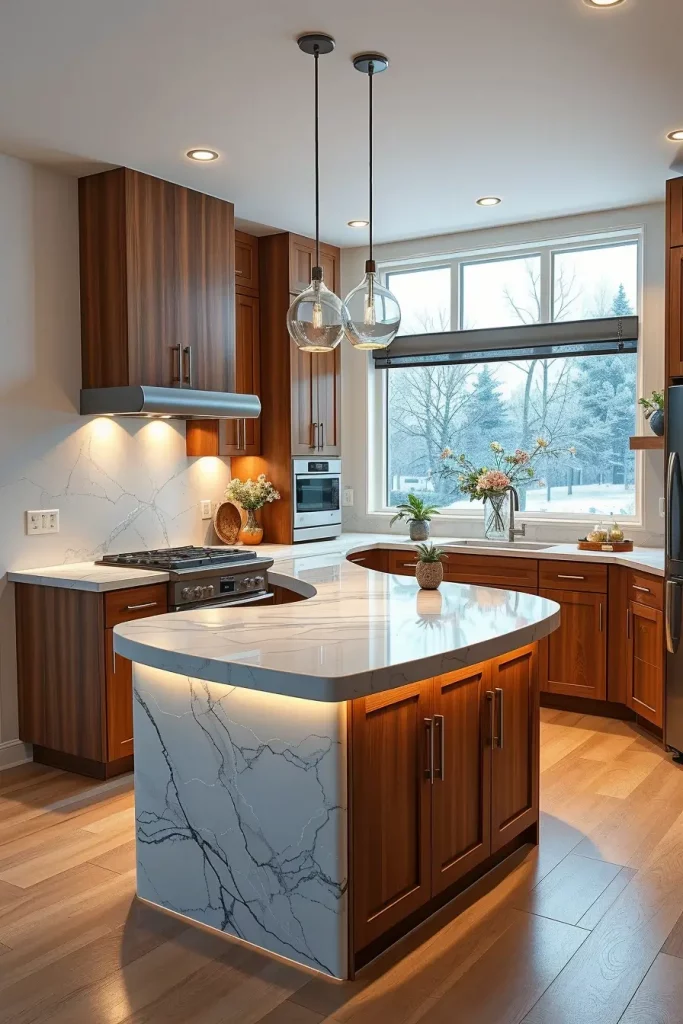
The materials such as quartz, marble, or wood can be cut to fit the curve, and the waterfall edge with a round drop will increase the feeling of flow. I also prefer to incorporate under-counter lighting which follows the curve, which subtly illuminates its shape at night.
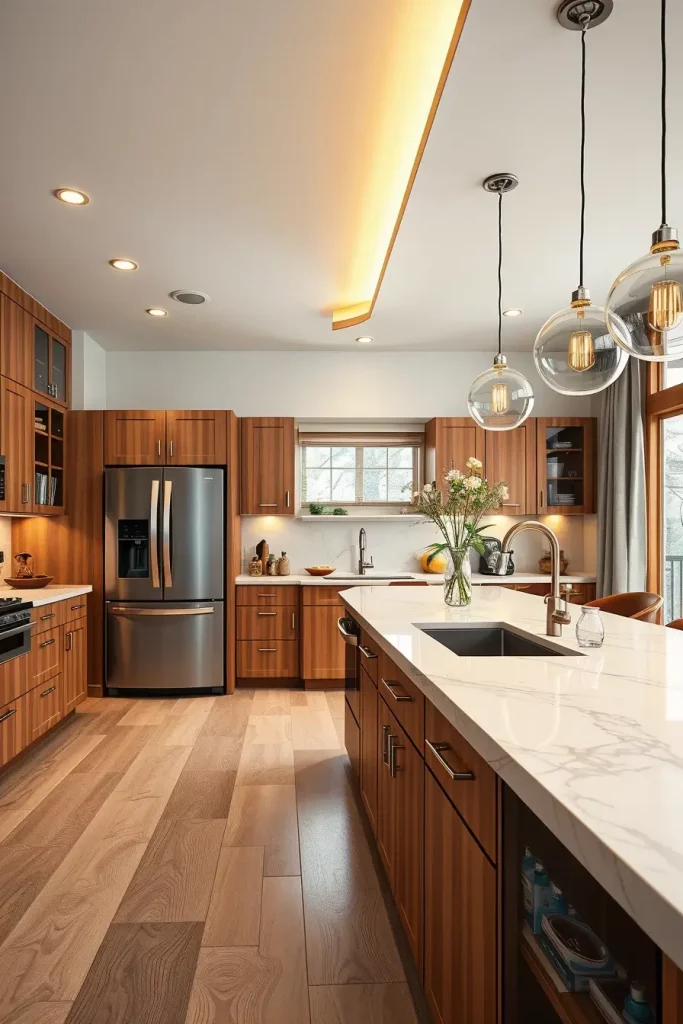
In my opinion, curved countertops promote socializing in the kitchen because people can form around them spontaneously. They also aid in space optimization especially in small or odd shaped kitchens.
Gentle Arches In Kitchen Doorways
The kitchen is framed by an arched doorway that makes it elegant. I most often recommend it when the client wants a discreet yet effective architectural feature. The arch may be structural or it may be combined with decorative trim to emphasize the shape.
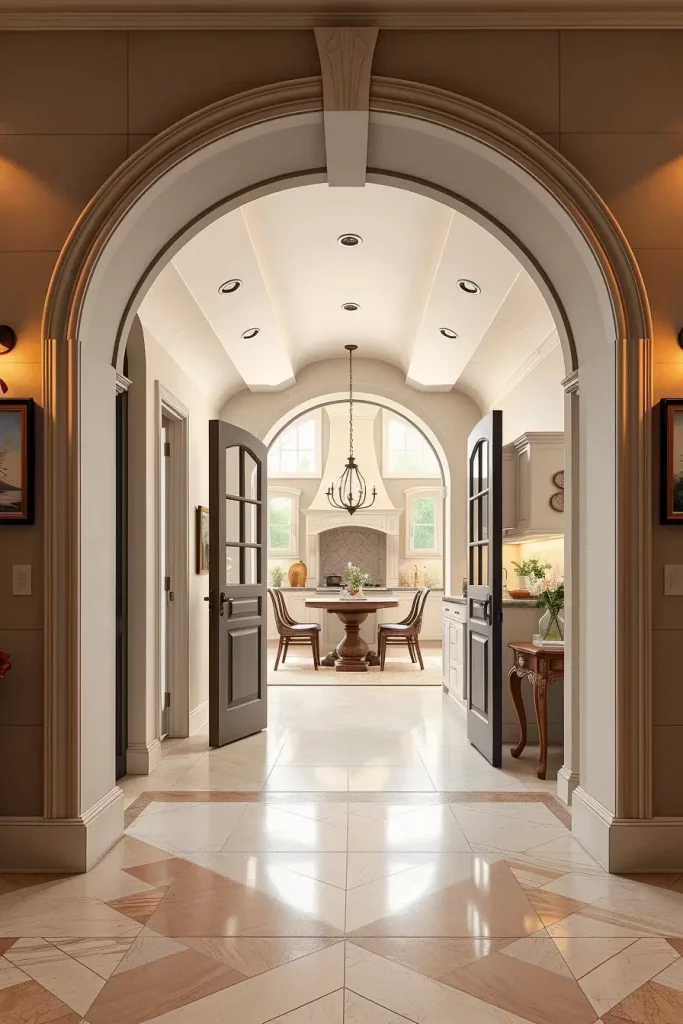
Arches are very effective in transitional areas and the flow of rooms becomes purposeful and elegant. I have employed plaster, wood or even stone surrounds to add to the overall material palette of the kitchen.
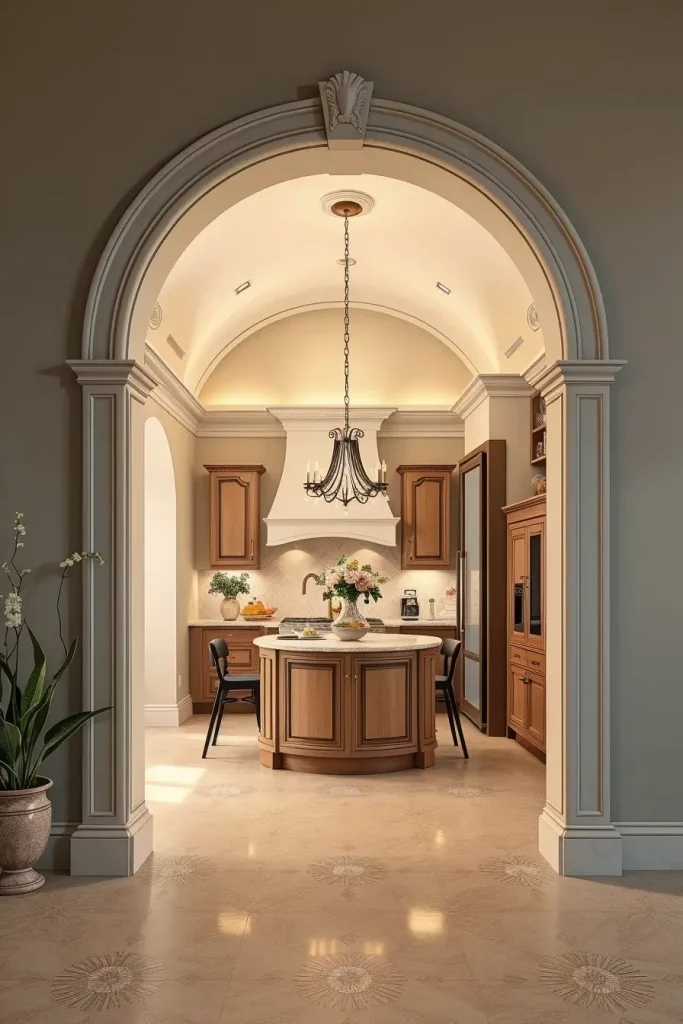
To my mind, mild arches create a mood even before you enter the kitchen, it is a kind of visual greeting, it introduces visitors and smooths the building lines of the house.
Flowing Edge Designs For Cabinets
Flowing edge cabinetry adds a sophisticated softness to the central storage features of the kitchen. I tend to make the cabinet doors rounded at the vertical edges or with curved corner units to remove the sharp ends of the old boxy designs.
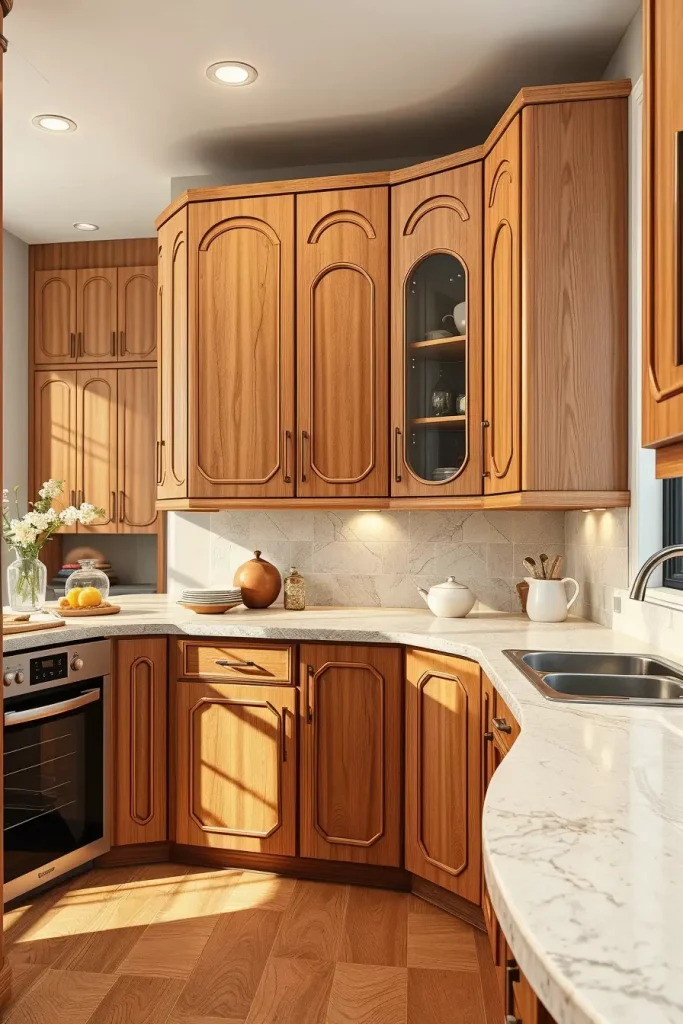
The hardware selection is important here long, slender handles with rounded off ends or inset pulls that curve with the door are what make the appearance consistent. These cabinets are combined with a curved countertop corner of the same design to provide a visual continuity.

This is one of the details that are frequently ignored, but that makes a huge difference, according to my professional opinion. It is a minor improvement that makes day-to-day use of cabinets more comfortable and elegant.
Softly Shaped Breakfast Nooks
A breakfast nook is an ideal spot to add some soft curves and I have discovered that a rounded seating arrangement immediately makes it feel more cozy. It could be an integrated banquette with a crescent-shaped bench or a small circular table, but the curves make people turn to each other.
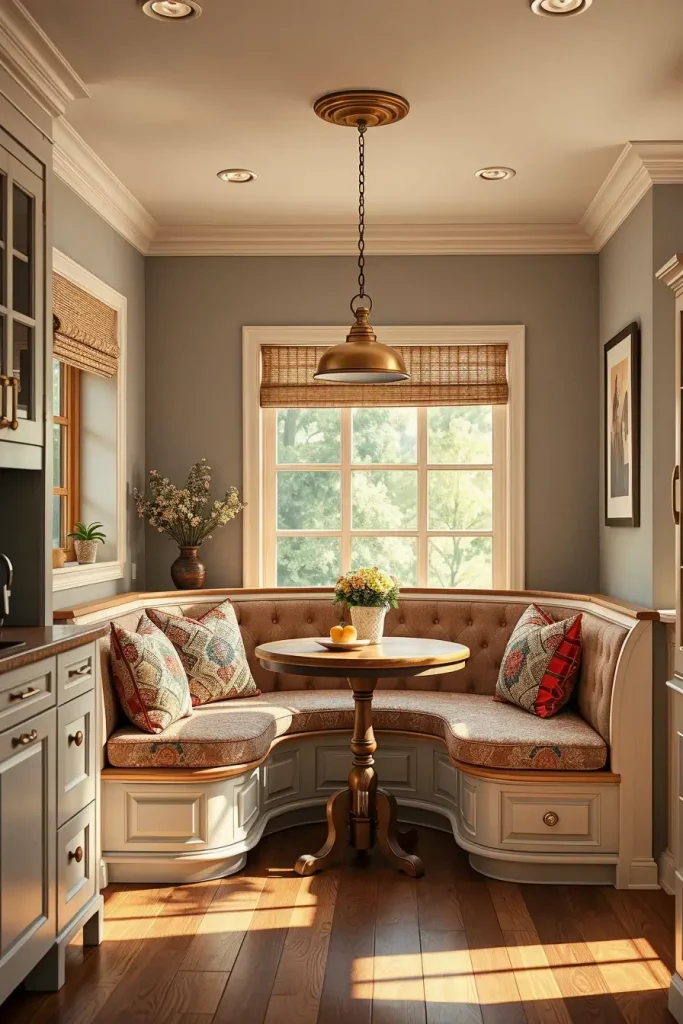
Lightweight upholstery or leather will be comfortable and pendant lighting above the table can repeat the curve below. I occasionally add under-seat storage to the banquette to make it more functional.
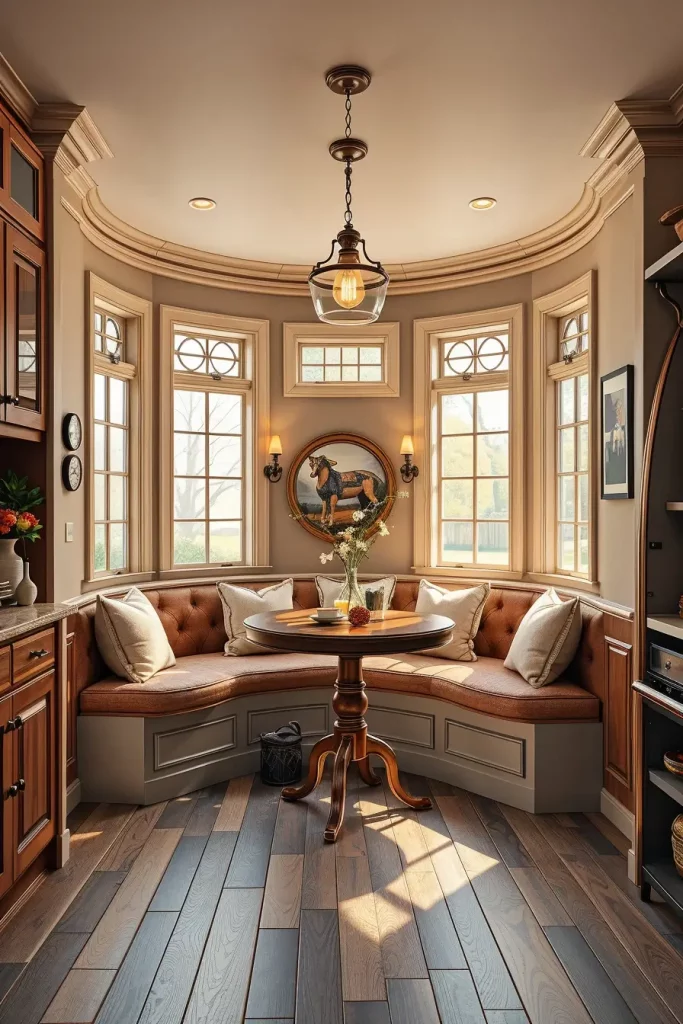
In my experience, these softly formed spaces are particularly effective in kitchens where informal eating is also a social center. They establish a feeling of intimacy which is difficult to obtain with rigid and straight layouts.
Wave-Inspired Kitchen Backsplashes
A wave-like backsplash can be a beautiful focal point and yet keep the theme of soft curves. I prefer to employ tile patterns or stone cuts which are flowing, wave-like, as opposed to being adherent to the strict rectangular grid.
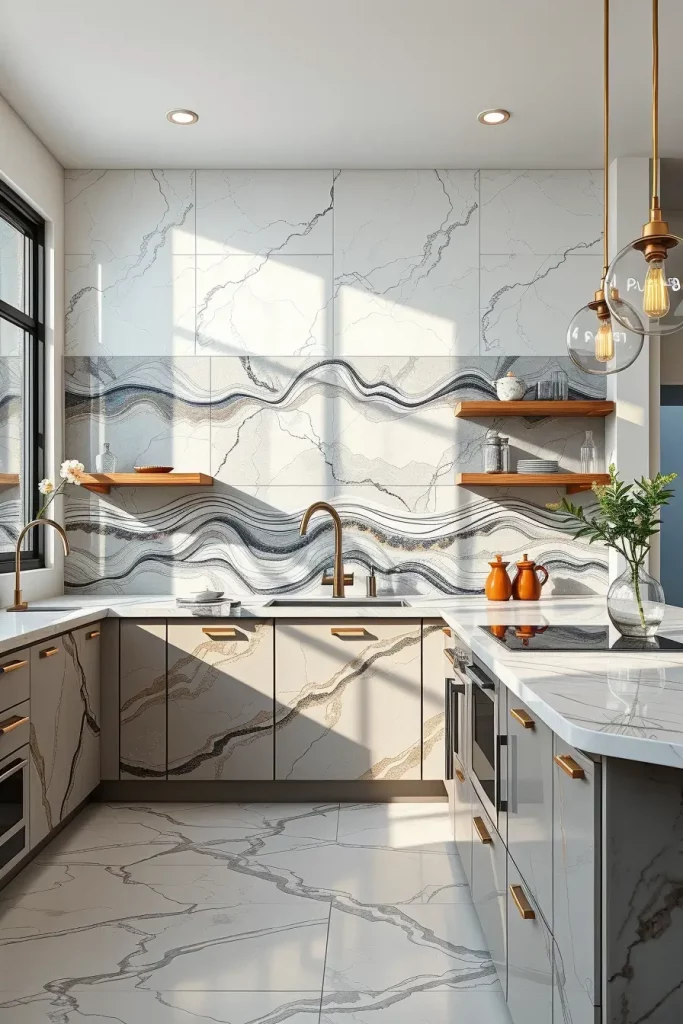
The effect can be accomplished with glazed ceramic tiles, marble slabs or even textured glass panels, which provide a visual interest and a sense of movement. It is possible to select the colors that blend smoothly throughout the backsplash to reinforce the illusion of waves.
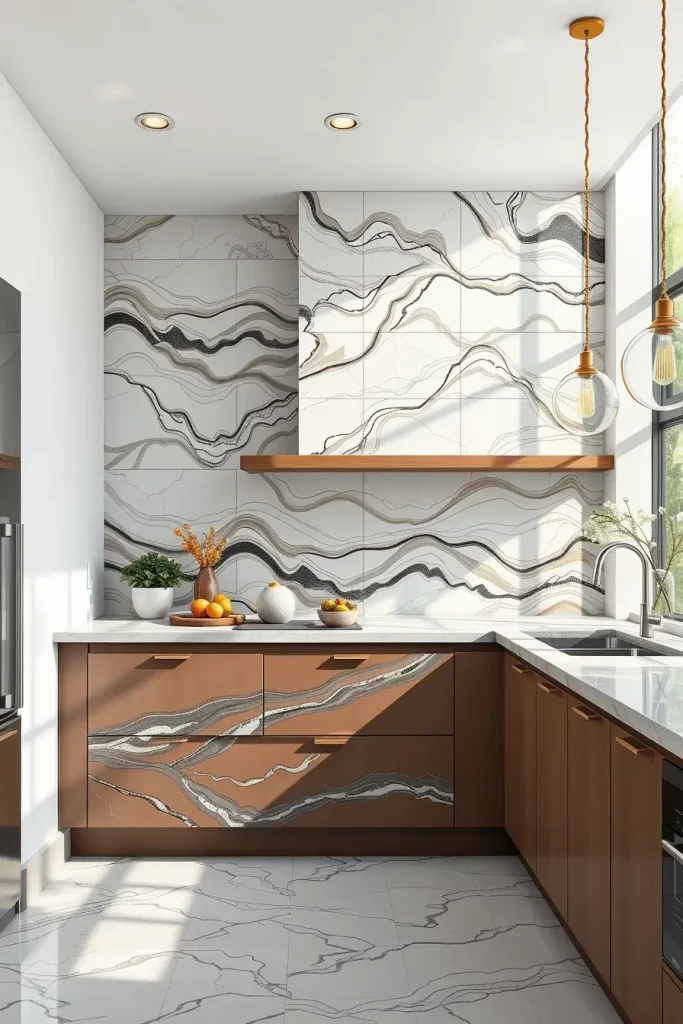
I think this is a perfect feature to have in case the client wants a focal point that does not overwhelm the overall rounded and calm look of the kitchen.
Rounded Shelving For Open Storage
Curved shelves are both decorative and functional to the open storage idea in a kitchen. I prefer to make them with rounded edges so they are not so heavy to the eye as the straight shelves are. They are particularly helpful in presenting decorative objects or most used cookware, and maintaining the room light.
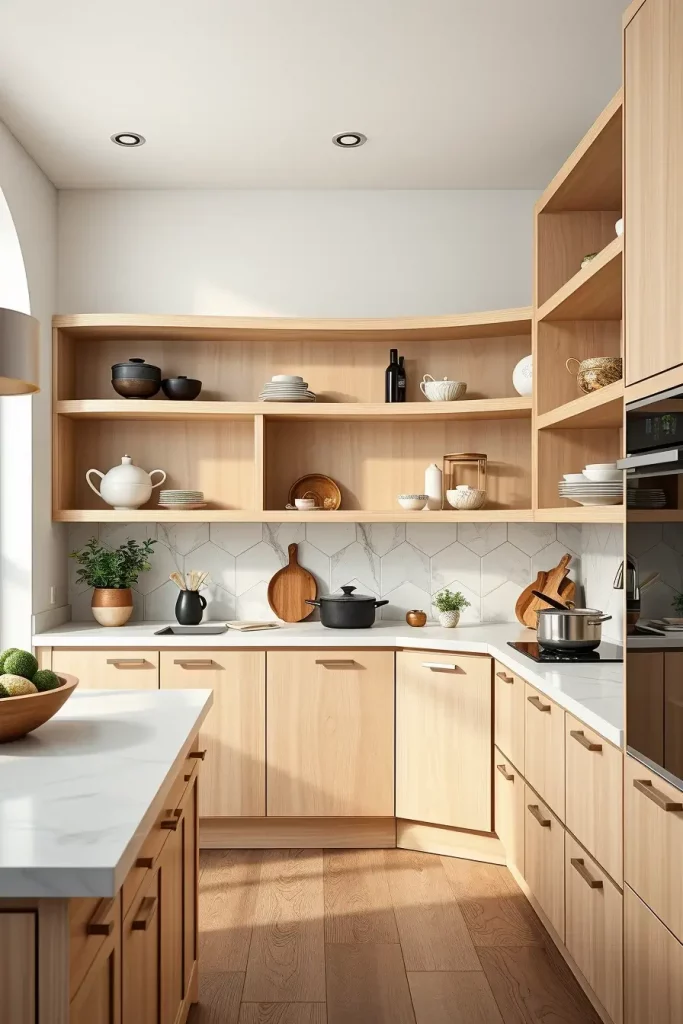
Light oak, painted MDF or even glass can be curved or cut into elegant curves. The brackets may be concealed to give a floating effect or the shelves may be incorporated into a curved wall niche to have a more built-in look.
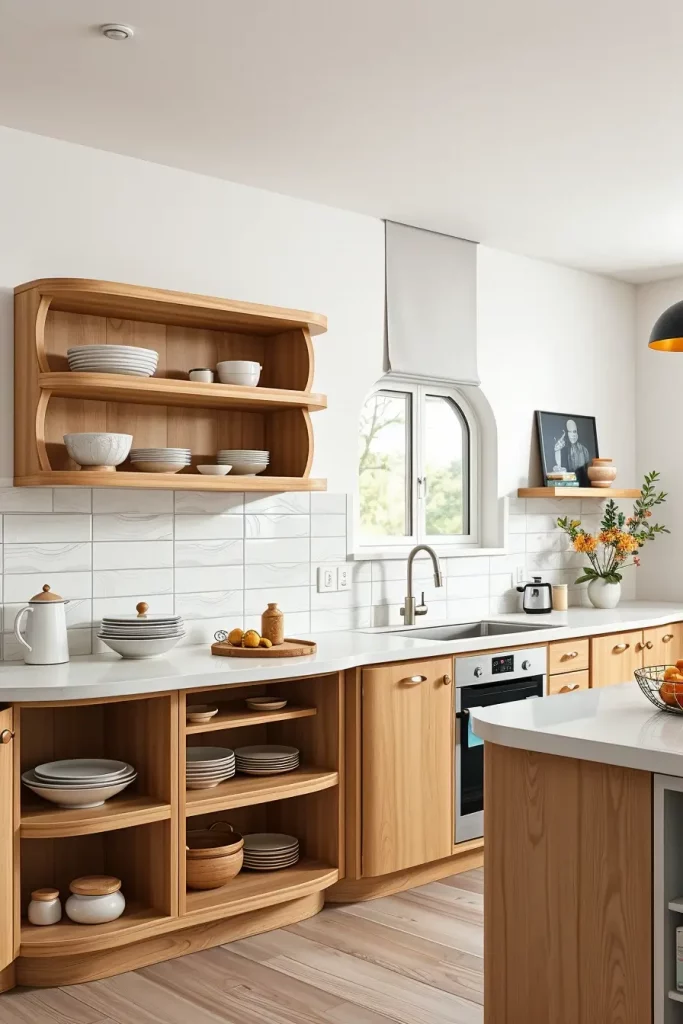
In my experience, corner spaces that are usually unused are ideal to be filled with rounded shelving that looks gorgeous. It gives character and forms a flowing visual connection between the upper and lower parts of the kitchen.
Sculpted Curves On Kitchen Peninsulas
Sculpted curves can be introduced in a kitchen peninsula. I tend to round the outer edge of the countertop to a slight arc to blur the boundary between kitchen and living room. This curve stimulates free circulation around the peninsula without the formation of a visual obstacle.
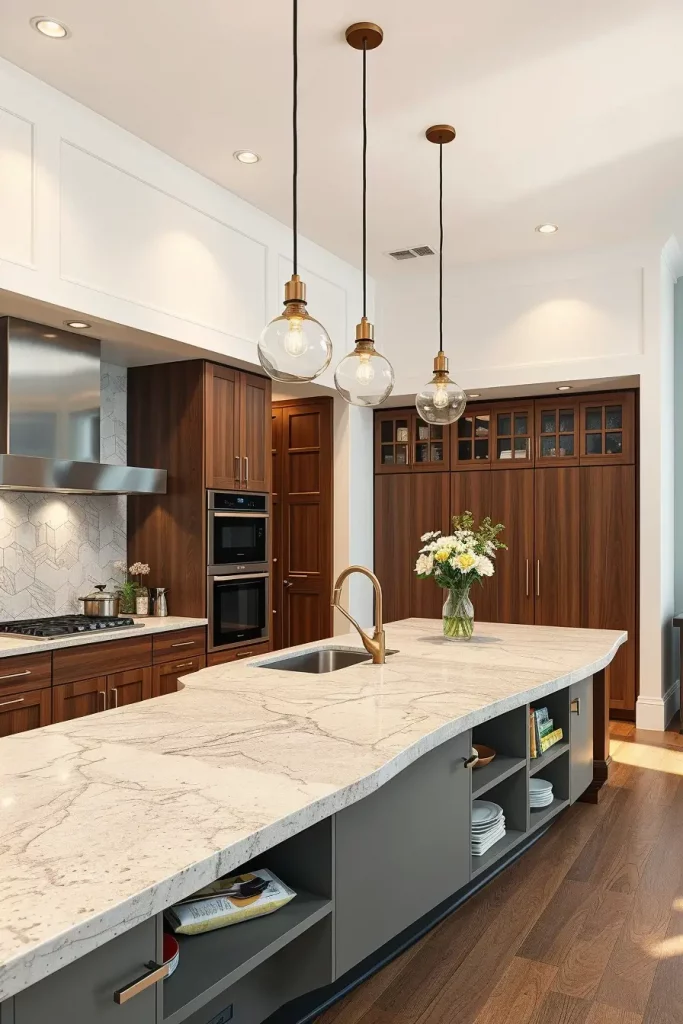
The base may be completed in paneling or custom millwork that takes the contour of the curve. The design can be maximized by adding an under-counter storage or a wine rack in the curve.
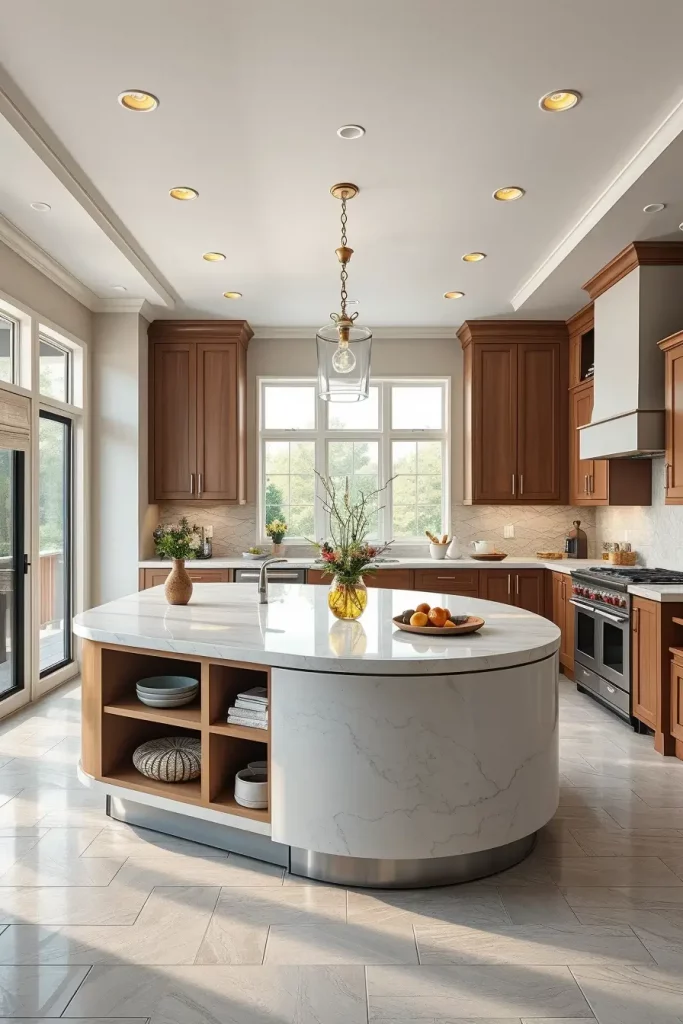
I also prefer the sculpted peninsulas in small kitchens because the shape opens up the space rather than closing it off.
Crescent-Shaped Kitchen Bars
Kitchen bars in the form of crescents add a fun, but mature element to a house. I position them in my designs so that they are a natural extension of the main kitchen area, and they form a small area to have drinks, snacks, or casual meals.
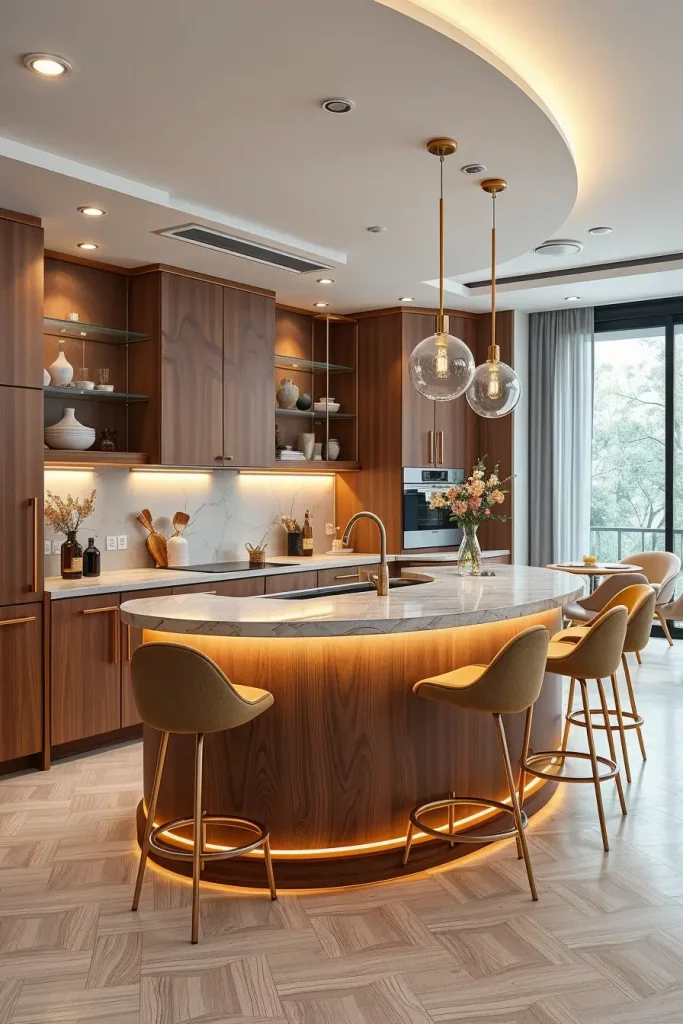
These bars may be constructed of a stone or solid-surface top, on a curved wood or upholstered base. I prefer to have bar stools that have rounded backs to follow the shape of the bar. The bar also has soft LED lighting under the edge of the bar to add to its sculptural quality at night.
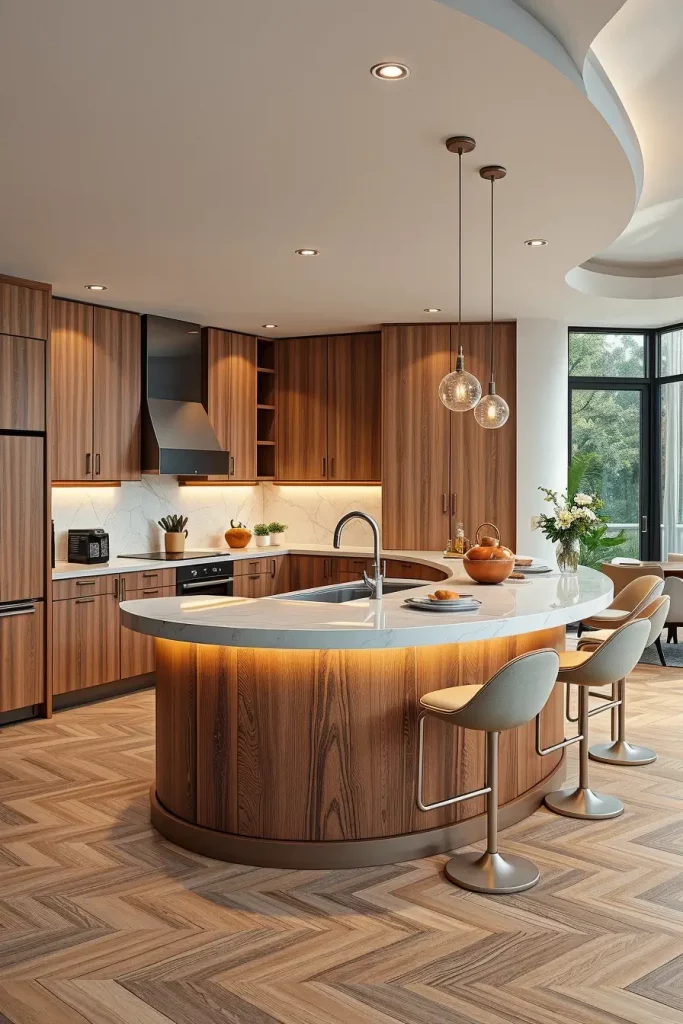
I, personally, adore the way crescent bar is welcoming and yet somehow divides entertainment space and main cooking area.
Organic Forms In Kitchen Layouts
Organic-shaped kitchen layout does not only mean furniture but the entire flow of the room. I tend to shun strict grids in preference to smooth, curving pathways and working areas. This will make the pattern of circulation more natural and people will intuitively move through the kitchen.
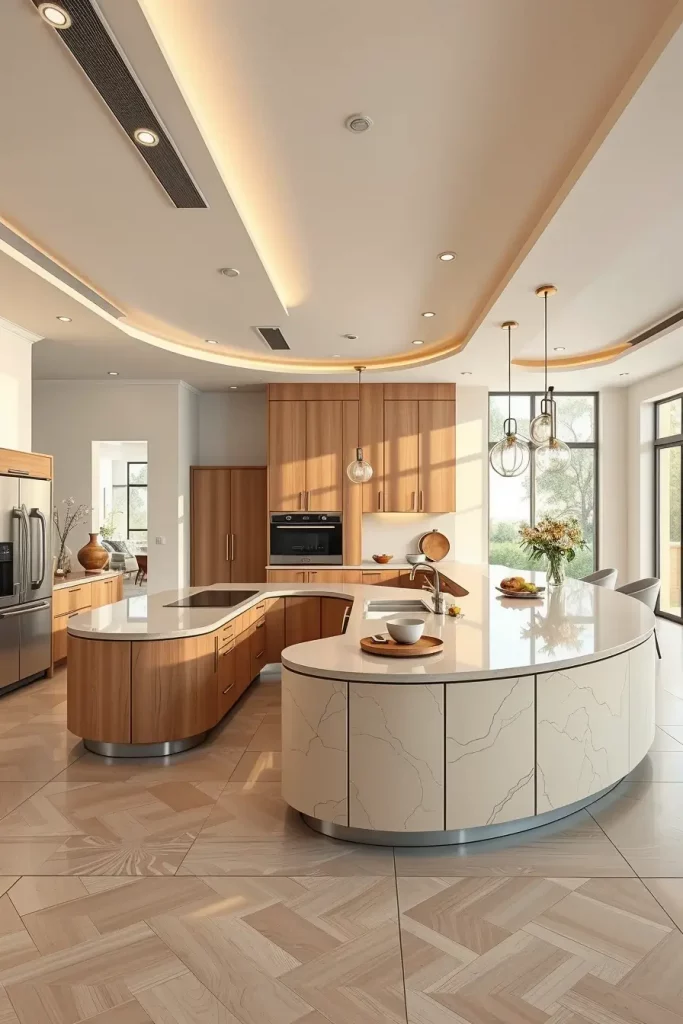
The arrangement of islands, counters and appliances is in curves which are an extension of the architecture of the room. The kitchen is not broken up into different zones as the transitions between zones are rounded, e.g. cooking and dining.
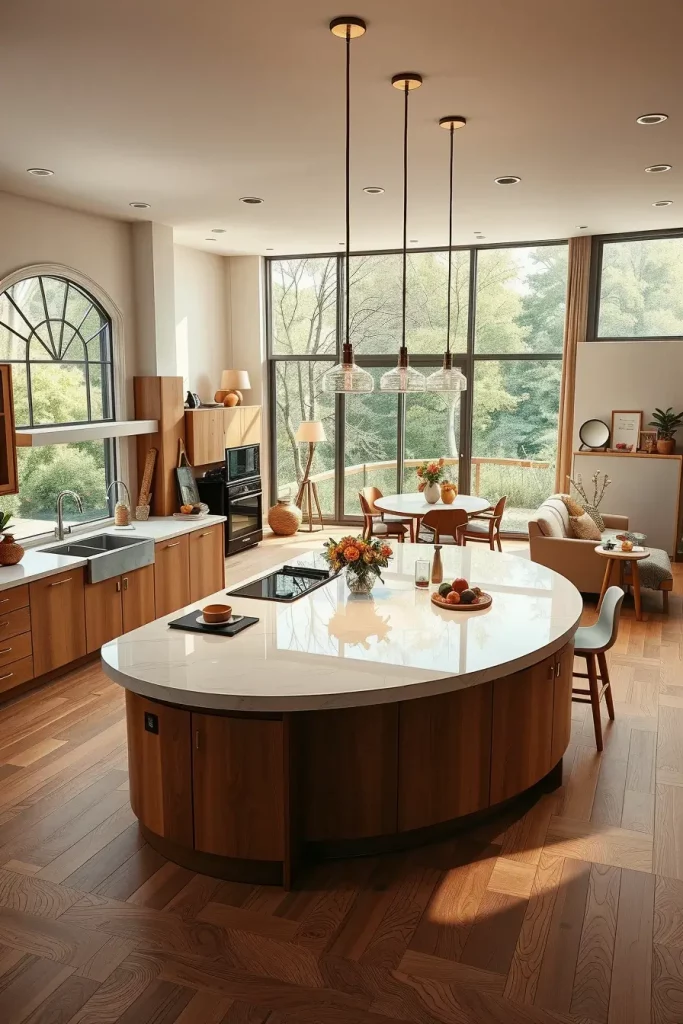
In my opinion, organic layouts promote socialization and allow the kitchen to be more flexible both in terms of cooking and entertaining.
Dome-Like Kitchen Ceilings
A ceiling which resembles a dome can totally change the mood of the kitchen. I have deployed this effect to create architectural drama and yet maintain a space that is soft and welcoming. The rounded ceiling automatically forces the eye to look up and the room appears bigger.
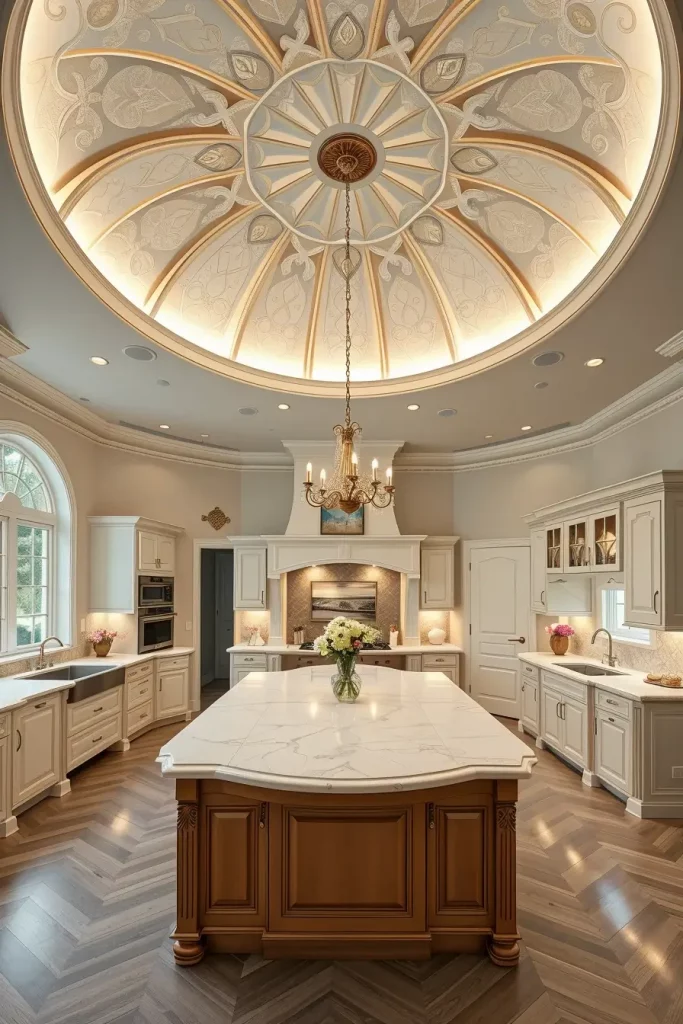
The dome can be enhanced by finishes including smooth plaster, wood paneling or even painted murals. Around the dome, there is integrated lighting that creates a slight glow, but does not distract the design.
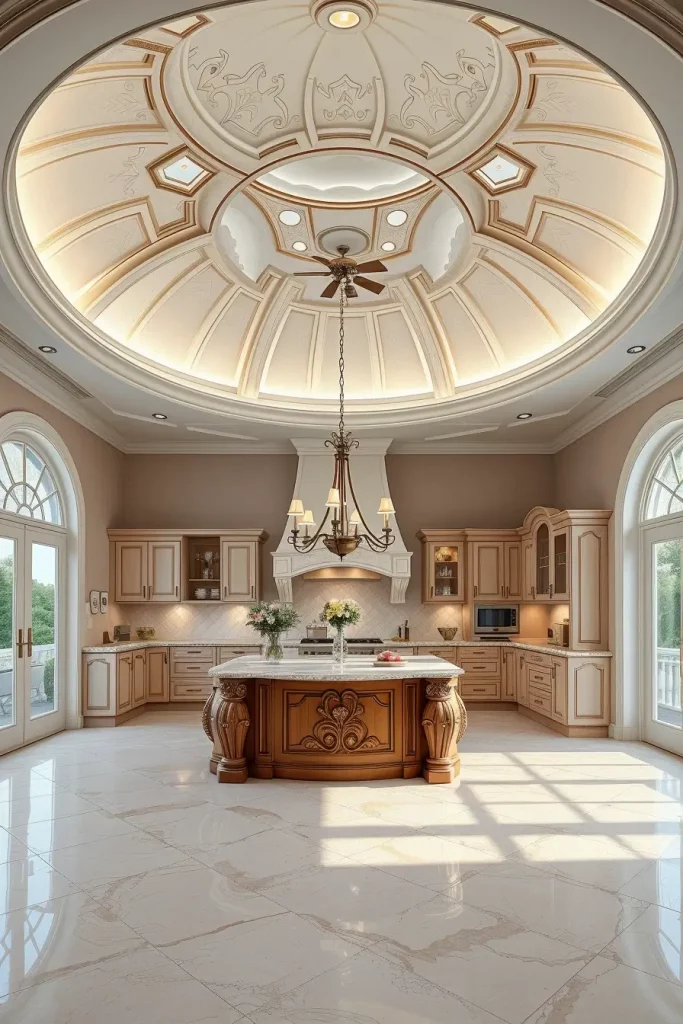
I believe that the dome-like ceiling is most suitable in the kitchens that have a lot of space, yet in the smaller rooms, a shallow dome can make the room look more elegant and deep.
Fluid Lines In Kitchen Lighting Fixtures
One of the simplest methods of adding soft curves to a kitchen is lighting. I tend to use pendant lights, chandeliers, or sconces with curvy shapes that are reminiscent of other curvy objects in the room.
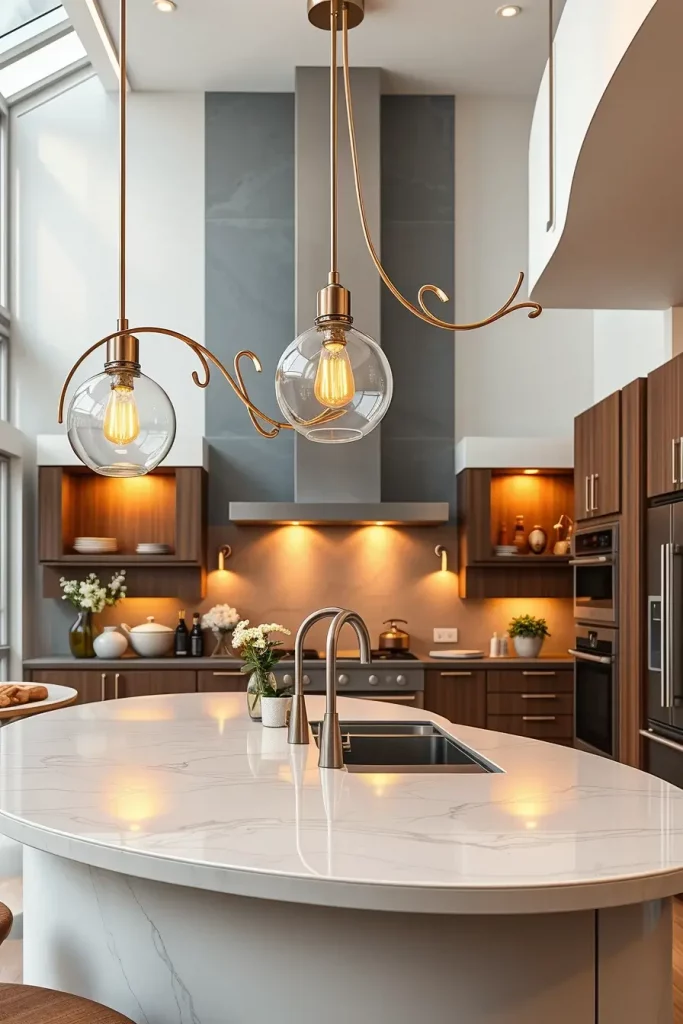
Brass, glass, or matte black metal fixtures, with rounded shades or sweeping arms, bring some motion to the ceiling. The design is unified by placing them strategically above islands, breakfast nooks or peninsulas.
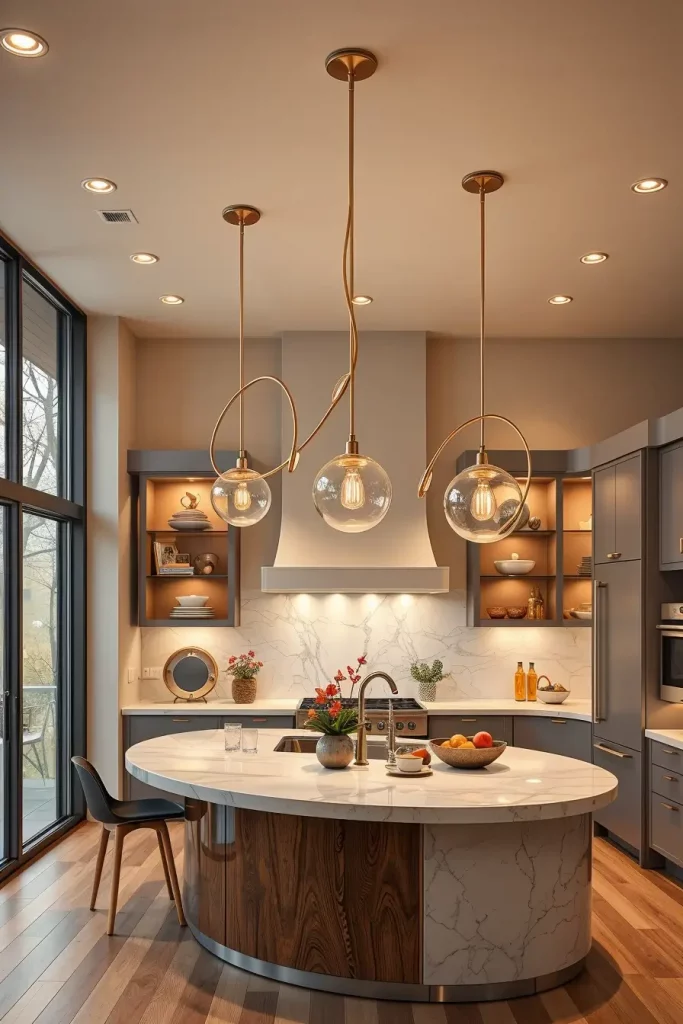
I have discovered that curved lighting fixtures are not only beautiful but they also disperse light in a more even way across the surfaces producing a warm, inviting glow.
Circular Dining Tables In Kitchen Spaces
The kitchen has a circular dining table that fosters unity. I would suggest them in small and large areas since they promote eye contact and communication at the dinner table.

Size is important, too, a table that is too big will dominate the kitchen, and one that is too small will be cramped. I like round tables of solid wood, glass or stone to be durable and stylish. The soft organic theme is further enhanced by complementing them with curved chairs.
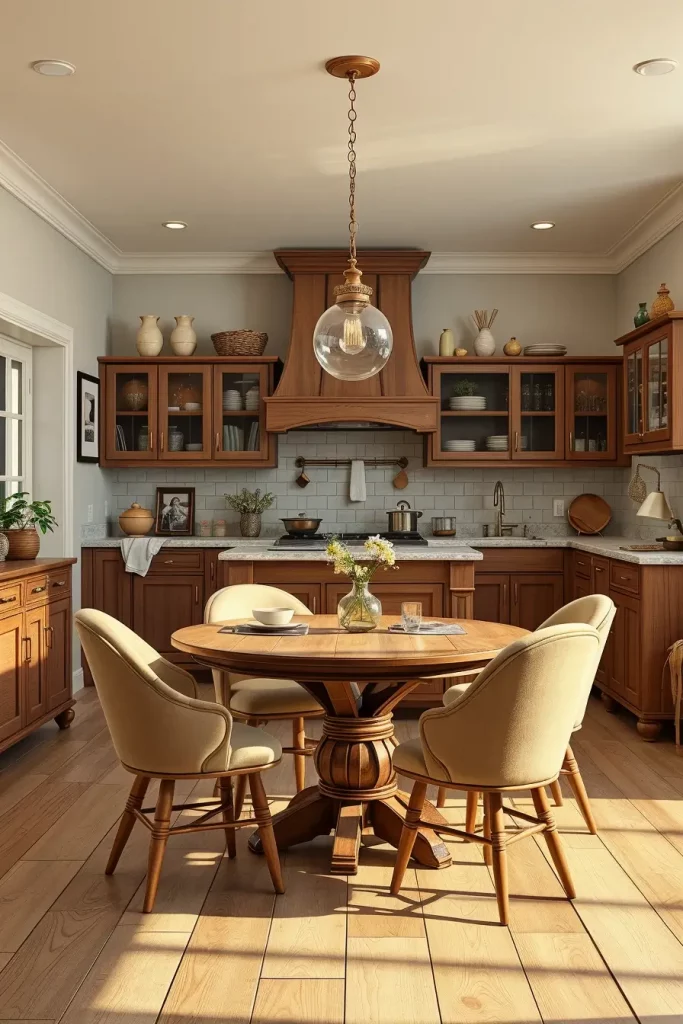
In my opinion, round tables will make the kitchen look more of a meeting place rather than a place of cooking, particularly with comfortable lighting and soft fabrics.
Elliptical Window Designs For Kitchens
I usually suggest elliptical windows in a kitchen to break the hard geometry that is so prevalent in cabinets and counter tops. These are soft curved windows with long lines that allow a lot of natural light to enter and at the same time offer a distinct architectural feature. Their form is inherently eye-catching and it looks great in modern and transitional styles. The effect is a bright center of attention that is both classy and casual.
In my planning, I prefer to have these windows over a deep farmhouse sink or a work area countertop. This makes sure that the daylight is cast where it is most helpful. The style can be complemented by selecting frames made of wood or matte black metal, as it will make the frames warmer or contrasting. Complementary features like rounded pendant lights or a curved breakfast bar can be used to echo the shape to give a cohesive look.
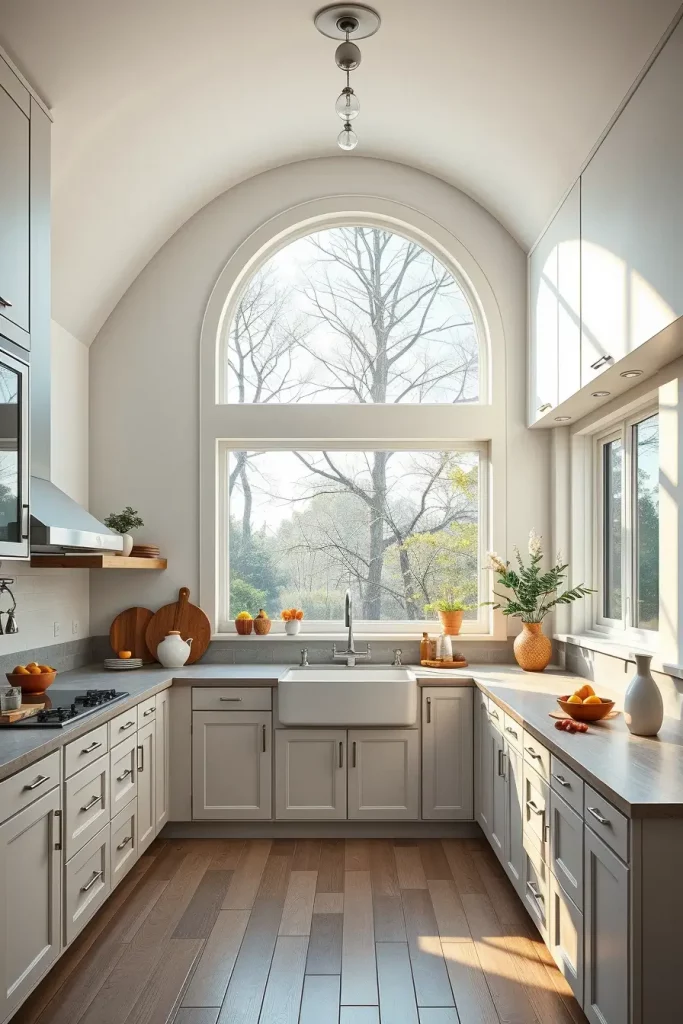
At a personal level, I have witnessed the way elliptical windows have changed the thoughts of clients about their kitchens in my own projects. They also give a room the illusion of height and openness when used with light colored walls. Architectural Digest tends to stress that the unusual shapes of windows are not only a decoration element, but also the factor influencing the understanding of the whole room proportions.
Rounded Range Hoods As A Statement
A curved range hood may be the jewel of a kitchen. Rather than the angular industrial-looking hoods we are used to, a soft, curved or cylindrical hood will give a sculptural feel. It can be the ideal combination of practical ventilation and eye-pleasing design.
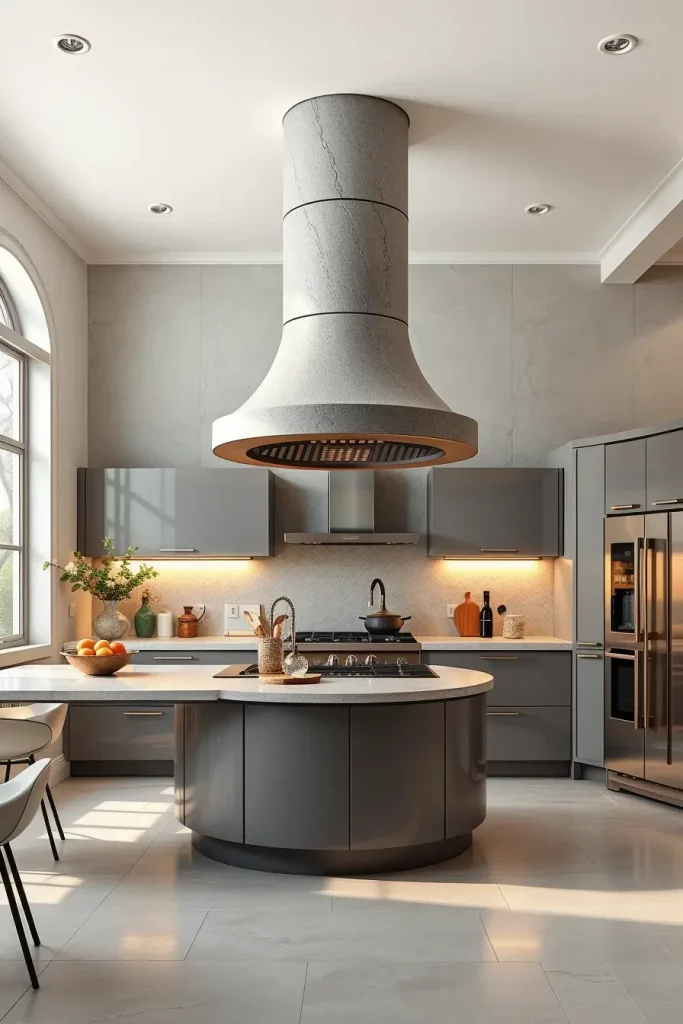
I usually order plaster-finished rounded hoods to give a Mediterranean atmosphere or brushed metal domes to give a more modern touch. The inclusion of subtle LED lighting under them not only makes cooking more visible, but also makes the form of the hood more appealing. The shape is contrasted against a neutral backsplash to ensure that it stands out, but does not dominate the room.
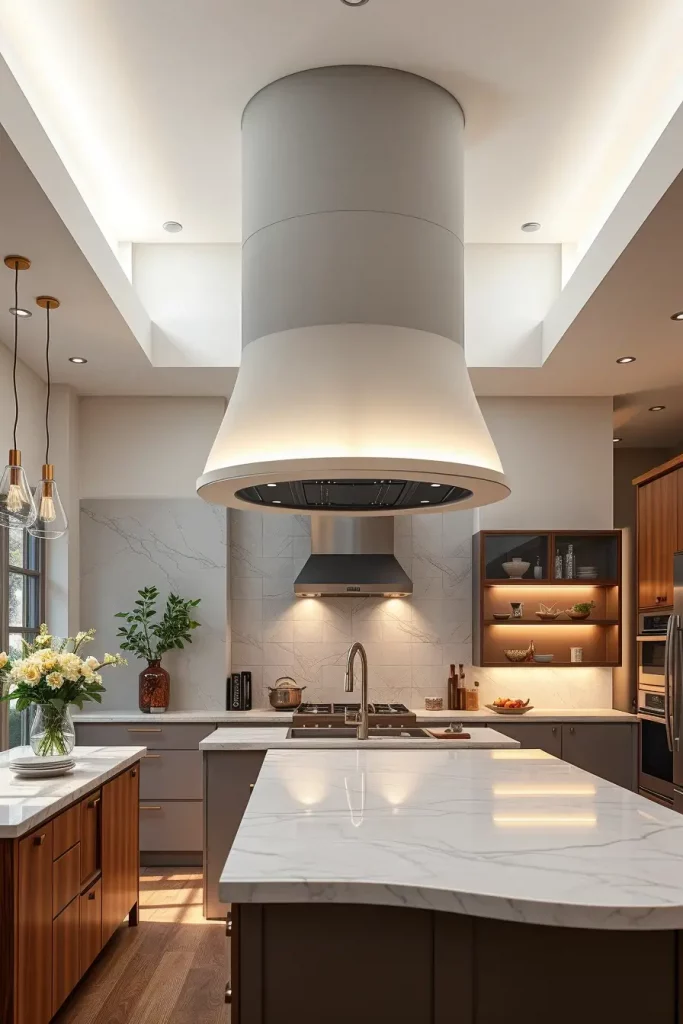
As a professional, I would say that a custom rounded hood is worth a penny- it immediately adds character to the kitchen. Elle Decor observes that statement range hoods can be used to ground the entire aesthetic of a kitchen, and are not merely a functional requirement.
Sweeping Lines In Kitchen Flooring Patterns
Flooring is one of the most ignored areas when it comes to soft curves in the kitchen but by incorporating sweeping, curved lines in the design, one can alter the entire ambience of the room in a very subtle manner. Be it in curved inlay borders of hardwood, or flowing tile mosaics, this detail of design leads the eye and gives a feeling of movement.
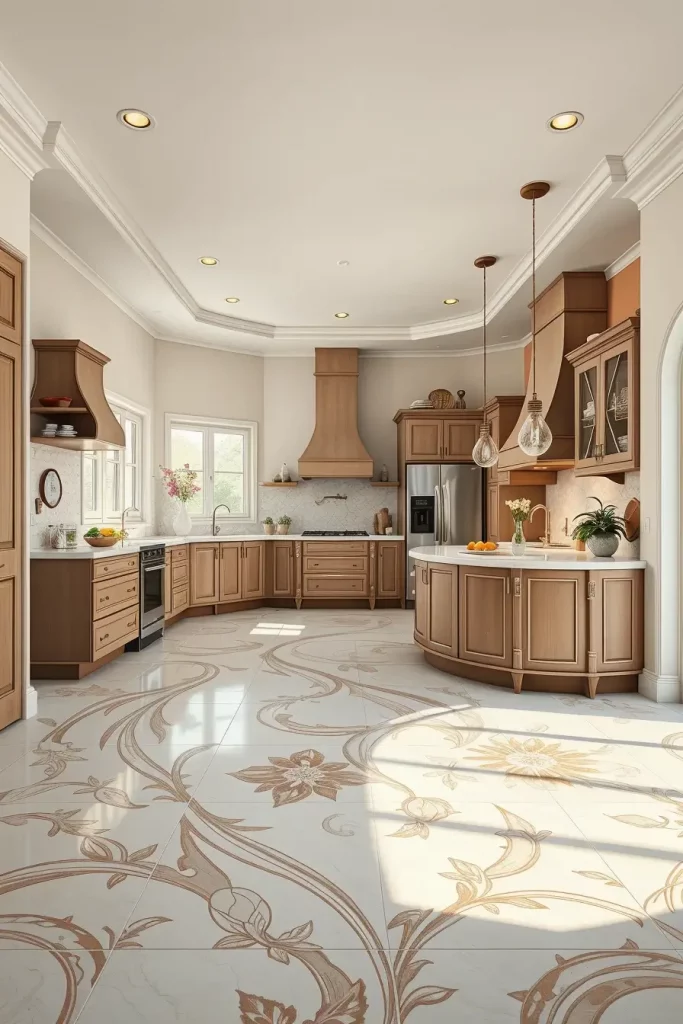
Personally I love large format porcelain tiles with a wave effect in open plan kitchens. To give a more craftsman-like appearance, a mix of contrasting stone can form a floor medallion of soft arcs. The trick is to make sure that the curve in the flooring is in harmony with other elements such as an arched island or a curved breakfast bar.
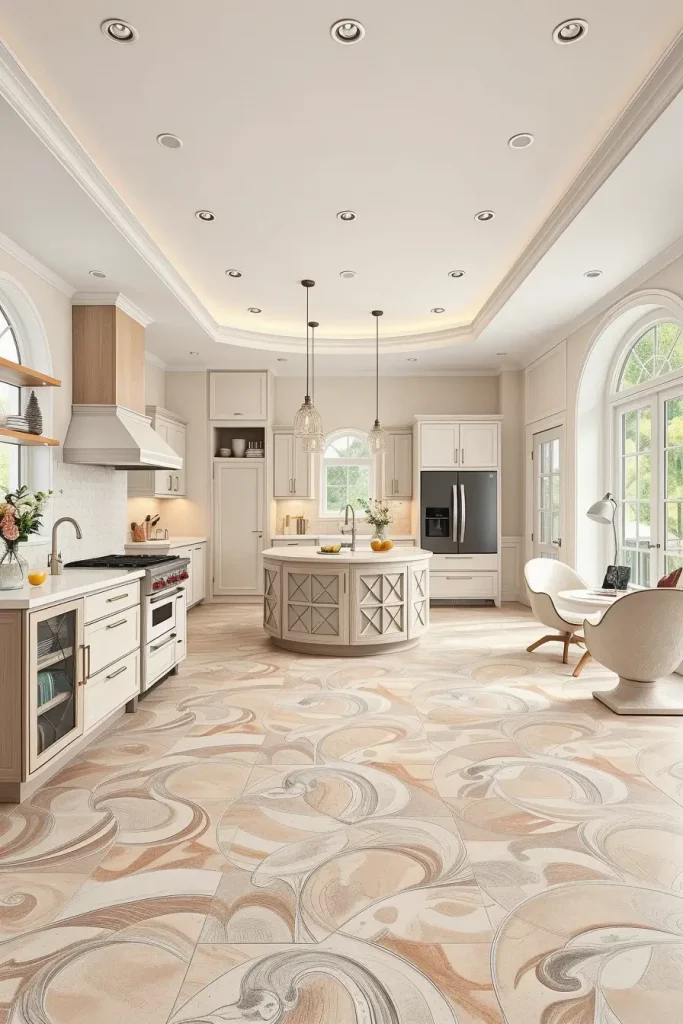
My personal installations have shown that curved flooring designs are more effective in larger kitchens because the design has space to breathe. They also are able to assist in defining areas in an open space without the use of walls or partitions.
Arched Open Shelving Above Counters
Open shelving is decorative and practical, especially in the form of arches. It will enable you to display dinnerware or cookware and will provide a beautiful architectural curve over your counters. The arch may be discreet, merely outlining the shelves, or dramatic, making a full half-circle.
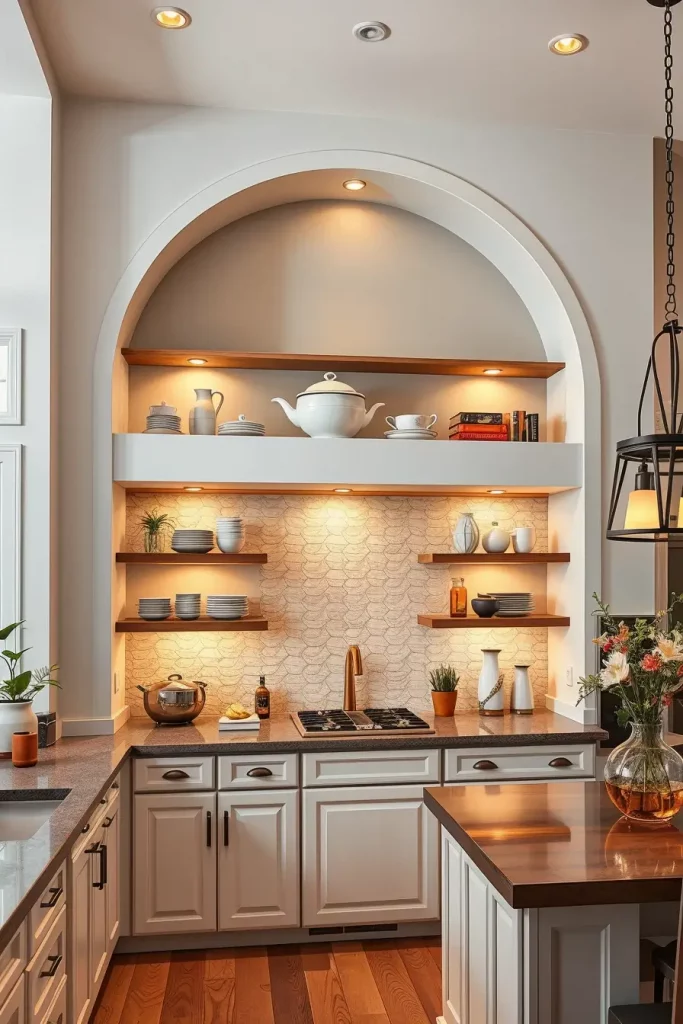
I like to make these shelves out of warm-colored wood to give them an organic look, or a painted finish to match the cabinetry so they blend. The inclusion of integrated lighting under every shelf is used to provide light to the items and give the kitchen a warm atmosphere.
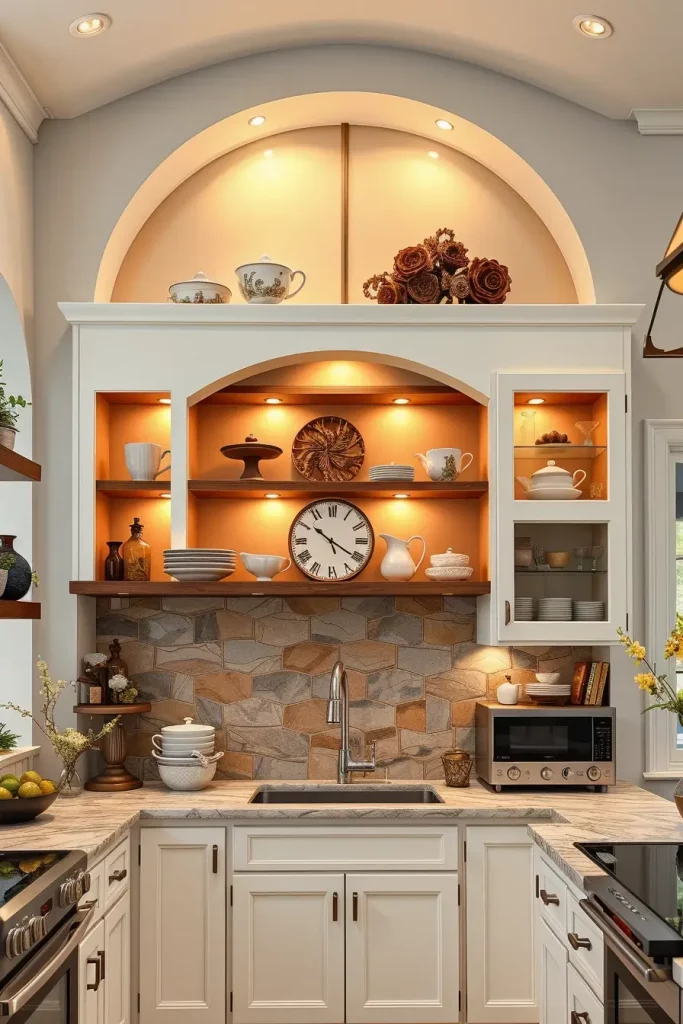
In my opinion, open shelves with arches can serve to visually soften a wall of upper cabinets as well. Better Homes & Gardens has also mentioned that open shelving can make kitchens appear larger and when an arch is added to it, the effect is even greater.
Gracefully Curved Kitchen Benches
A curved kitchen bench can totally transform the dynamics of a dining nook. Rather than a standard straight banquette, a semi-circular or slightly curved bench will promote conversation and be more inclusive. It is a perfect option at casual breakfasts as well as at bigger events.
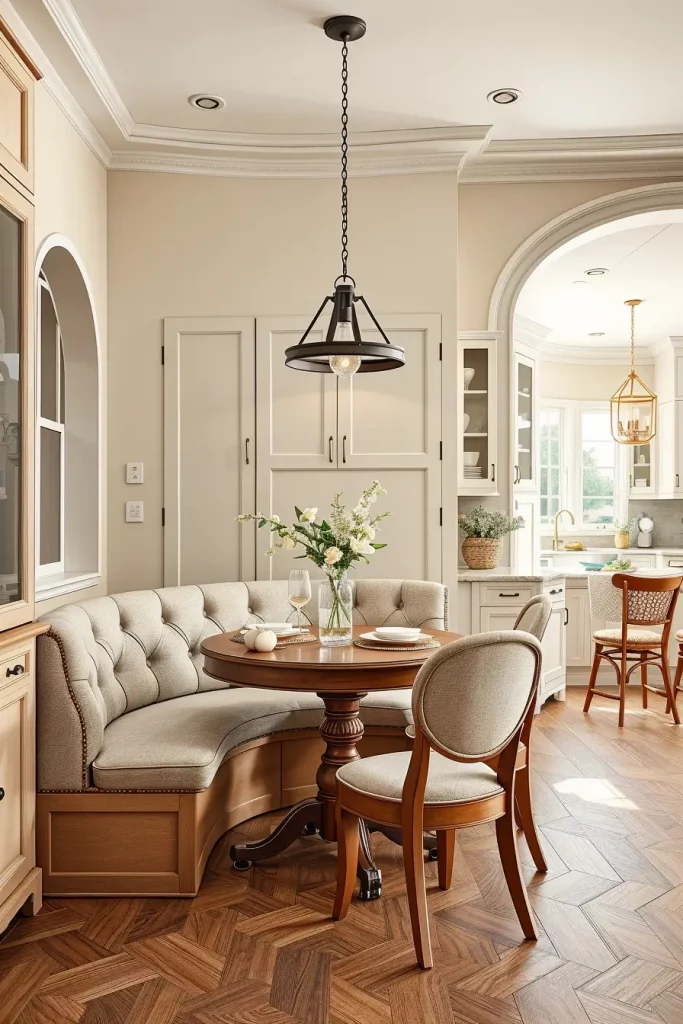
I prefer to cover these benches with hard-wearing and stain-resistant material that matches the other colors in the rest of the kitchen. The design can be connected to cabinetry or flooring by a wooden base of a similar curve. The table must also reflect the curve to be most comfortable and flowing.
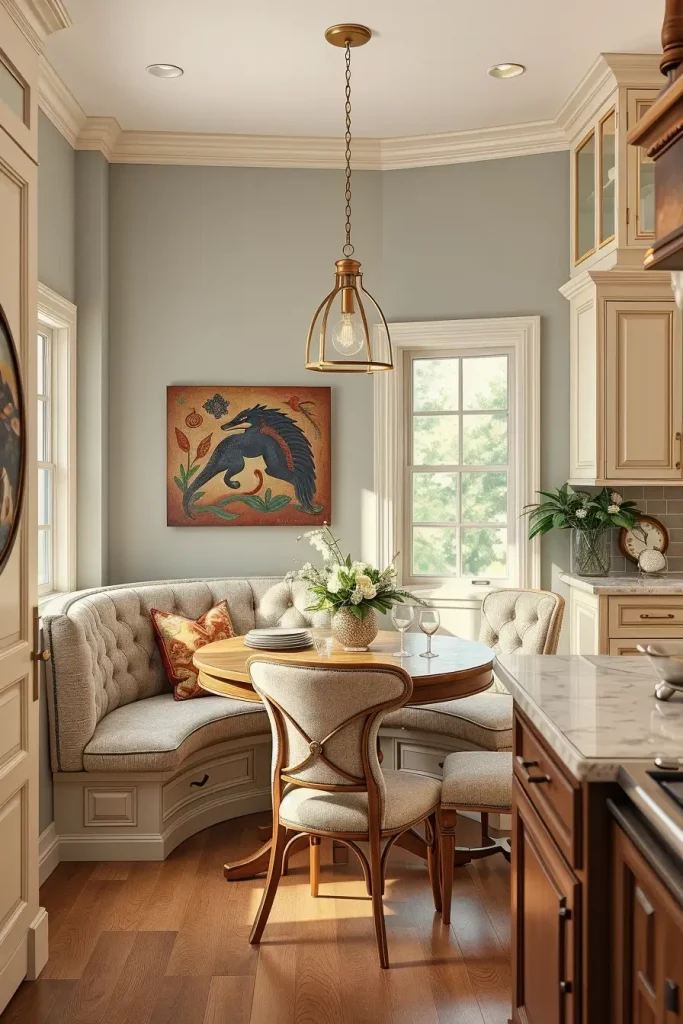
Personally, I have found that curved benches can make a small dining area appear more intimate and can maximize seating. They also do away with the embarrassing spaces that are sometimes present with straight benches in bay window arrangements.
Flowing Forms In Kitchen Wall Art
Kitchen walls do not need to be plainly functional; flowing wall art can be used to give personality and support the theme of soft curves. This may be abstract prints in organic forms, sculptural ceramic wall work or even a painted mural with sweeping lines.
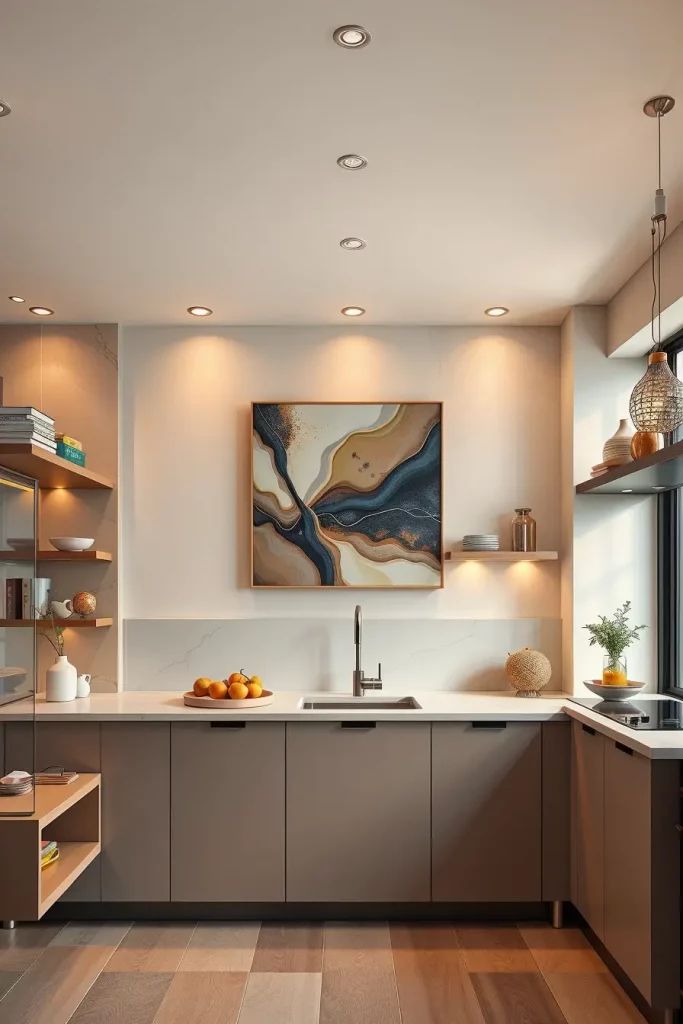
I prefer to make the color scheme of such artworks balanced with the rest of the kitchen, without too bright contrasts that may break the peaceful rhythm. Hanging art can be placed next to a place where people eat or on a plain wall to create a gallery effect.
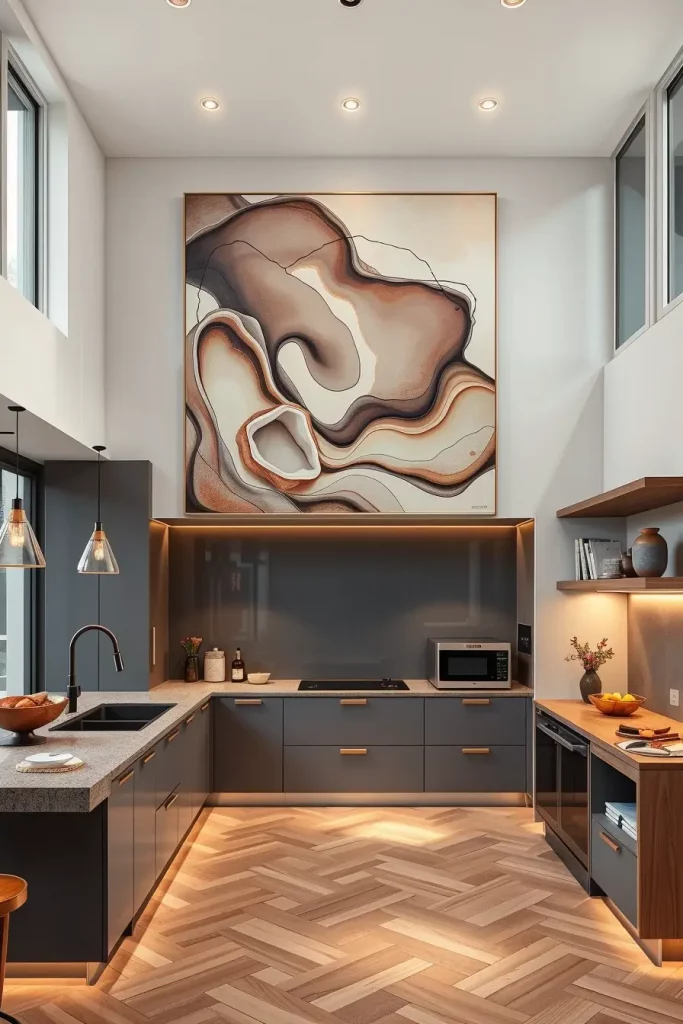
In my personal opinion, the kitchen is no exception to the rest of the rooms where art should be as purposeful as it is in the rest of the rooms. Just as Architectural Digest frequently recommends, decorating a wall to support the architectural decisions will create a consistent design narrative.
Smooth Corner Transitions For Safety And Style
The use of smooth corner transitions in kitchen cabinetry and countertops is a style decision as well as a safety precaution. These rounded corners are a continuous flow instead of the sharp 90-degree angles and are softer on the eye and safer to high-traffic areas. This has been particularly useful in the kitchens of busy families with children around.
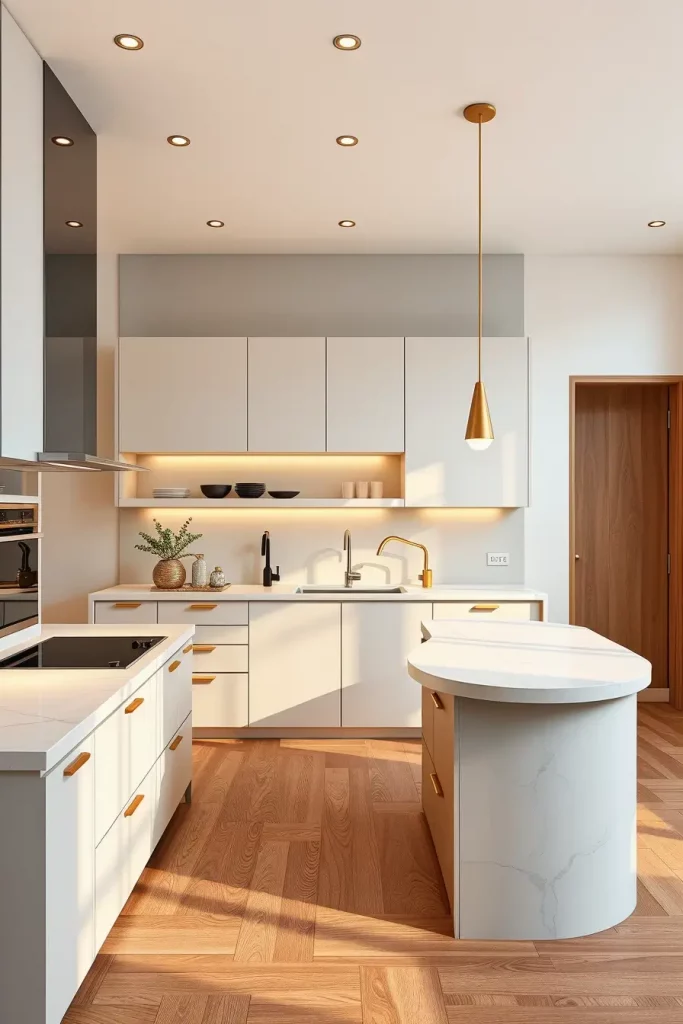
Design-wise, I tend to suggest the countertop corners be rounded, with the edges of the cabinets being softened as well to provide a visual cohesion. It is easier and more accurate to make such curves using materials such as quartz or solid surface as counters. This fact also fits in with other rounded elements, such as a curved island or archways, which binds the design.
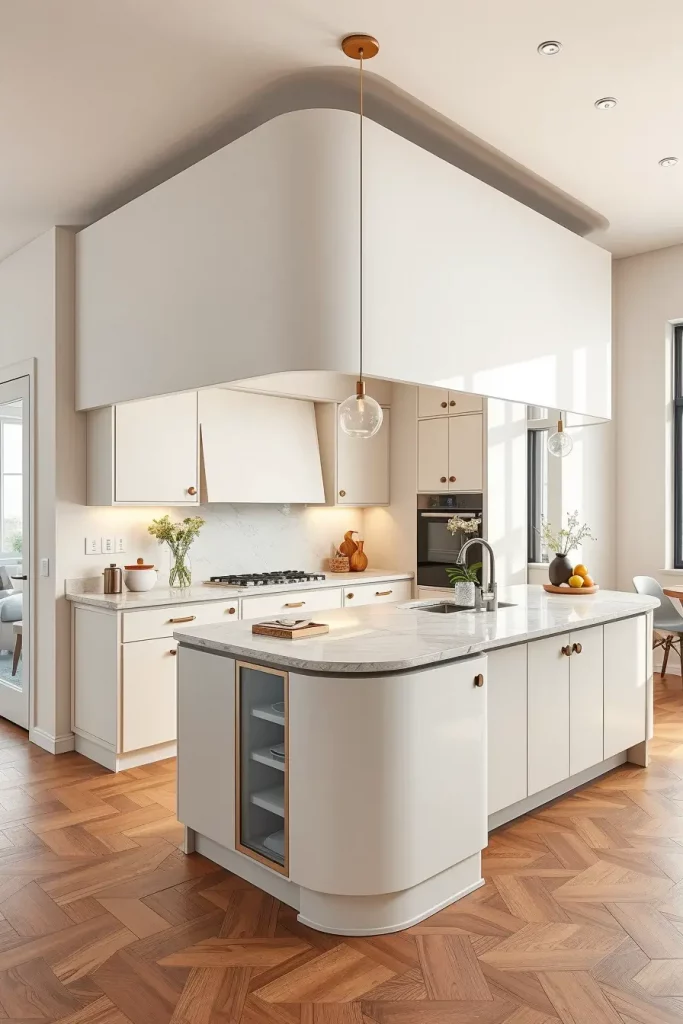
On a personal level, I have witnessed the immediate transformation of a kitchens feel, going from stiff to inviting, with the use of smooth corner transitions. House Beautiful has observed that seemingly minor things such as edge profiles can make a difference in how comfortable and fluid a space feels, so they are well worth the investment.
Semi-Circular Kitchen Islands With Seating
Semi-circular kitchen island is not only a design element, but also a multi-purpose area of cooking, eating, and socializing. The circular design promotes communication because individuals can face each other as opposed to the conventional linear islands. It also improves the flow of movements, which minimizes bottlenecks in a busy kitchen.
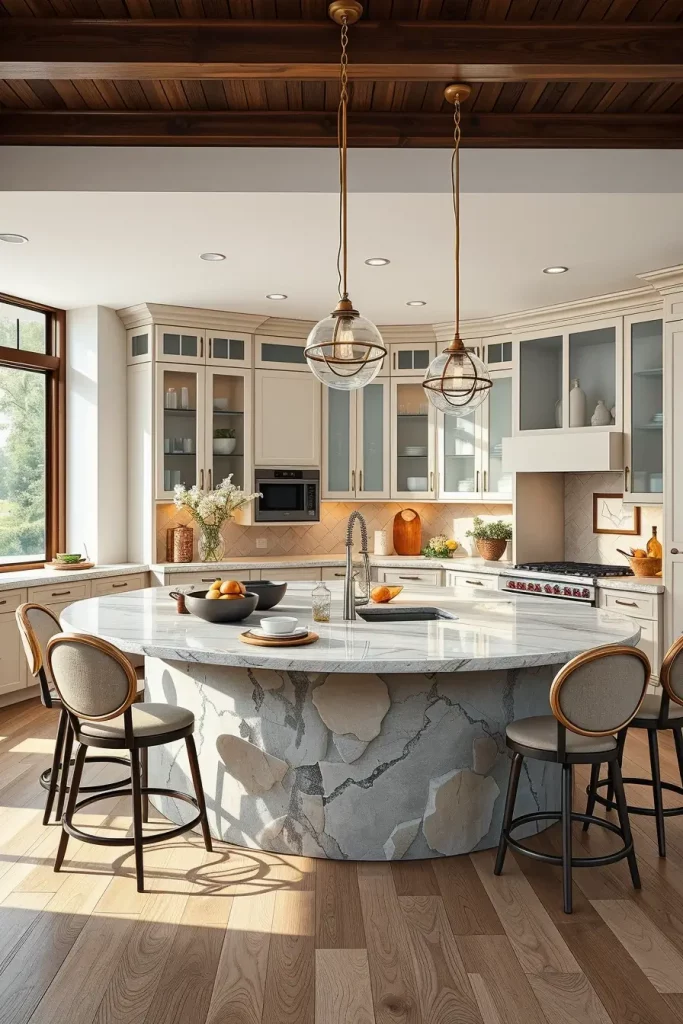
I usually recommend a waterfall countertop design to these islands whereby the material flows seamlessly around the rounded bottom. Rounded back bar stools are used to complement the shape and to be comfortable during informal meals. Adding under-counter storage will make the island not only beautiful but practical as well.
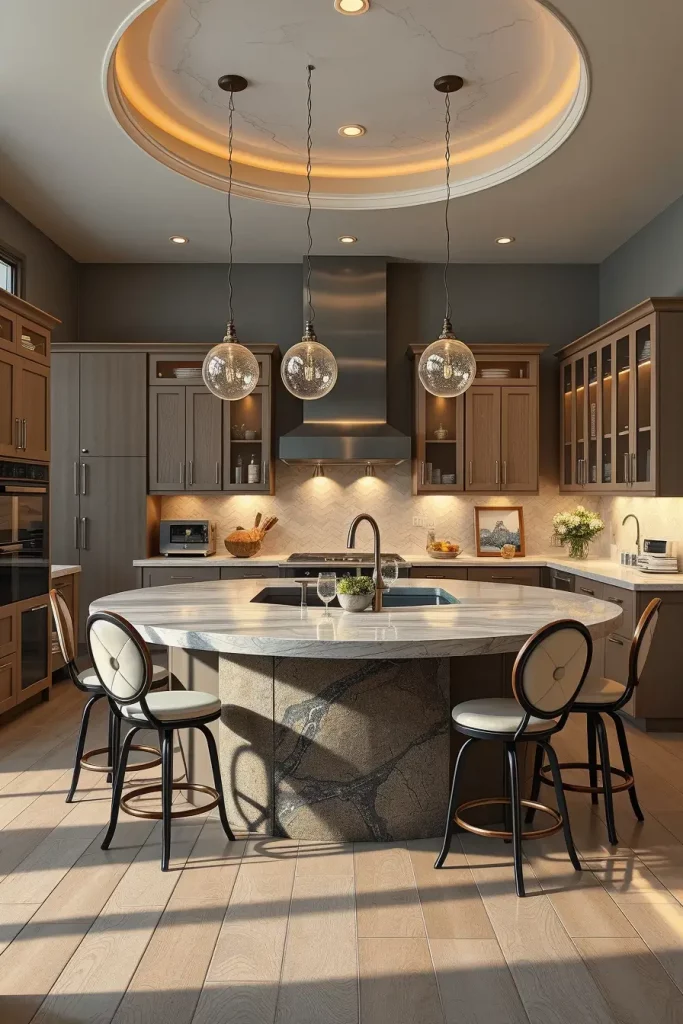
Based on my experience, clients adore how a semi-circular island is a natural gathering place. It mellows out the general kitchen design and is more welcoming than a typical rectangle, particularly in open plan living spaces.
Sculptural Curves In Kitchen Hardware
Kitchen hardware is an easy place to overlook when adding curves, but sculptural pulls and handles can be used to subtly support the theme of soft shapes. Round knobs, arched pulls and flowing handle shapes are functional and tactile.
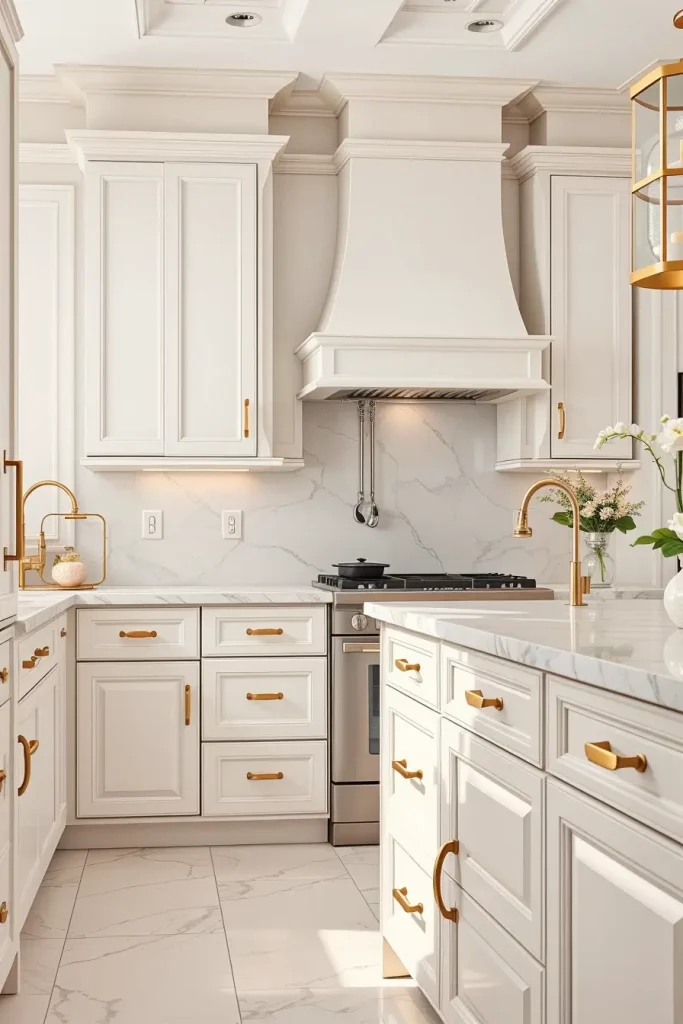
I prefer brushed brass or matte black finishes on curved hardware because they can be seen against light and dark cabinets. The combination of hardware curves with rounded edges of the cabinet or a curved drawer front makes a unified look. The trick is to select those designs which are comfortable to hold and at the same time aesthetically appealing to the space.
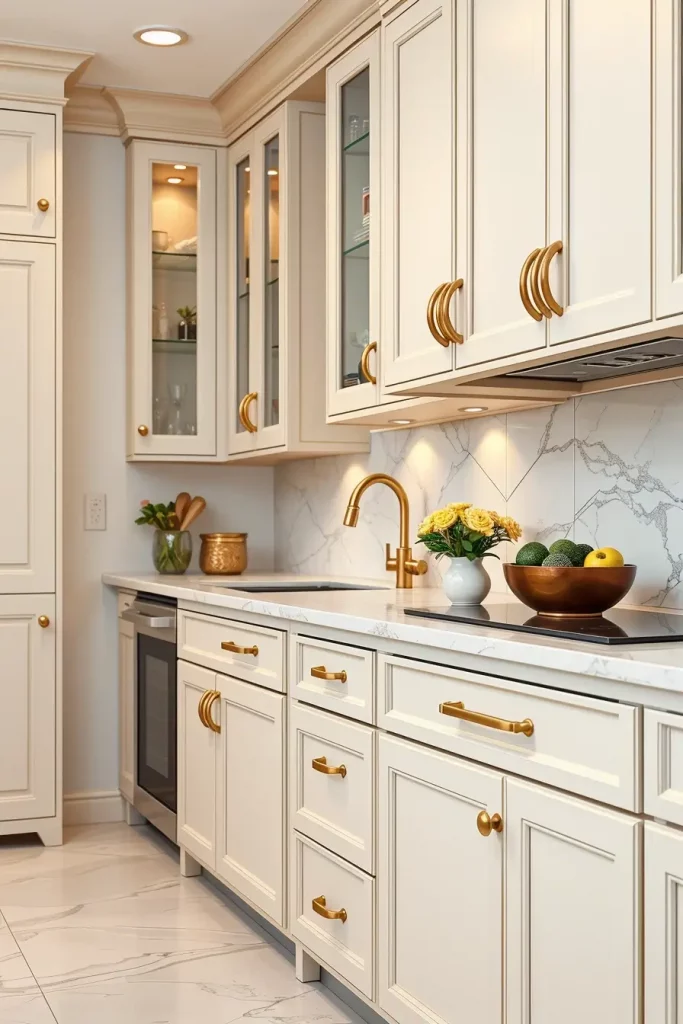
I think of hardware as jewelry to the kitchen, it is a small thing that makes a huge difference. As it is suggested in most design manuals, a good investment in quality, unique hardware can be used to upgrade the whole room without a total remodel.
Rounded Pantry Entrances
A circular pantry doorway turns an otherwise functional area into a design element. It can be a complete archway or a rounded, curved doorway but it makes the transition between the kitchen and pantry area smooth. The curve attracts the eye, and the point of entry seems to be purposeful and welcoming.
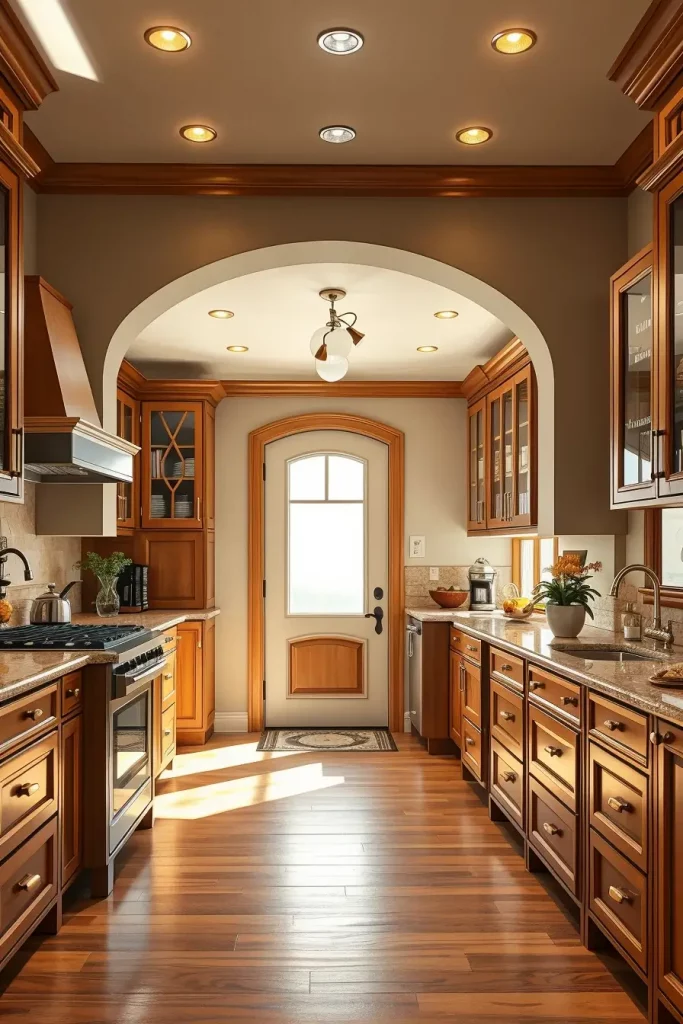
I like to surround these openings with natural wood or painted trim which matches the cabinetry to give a smooth flow. A frosted glass door, with an arched top, can provide privacy and style. The appearance is further balanced when combined with curved lighting fixtures or shelving.
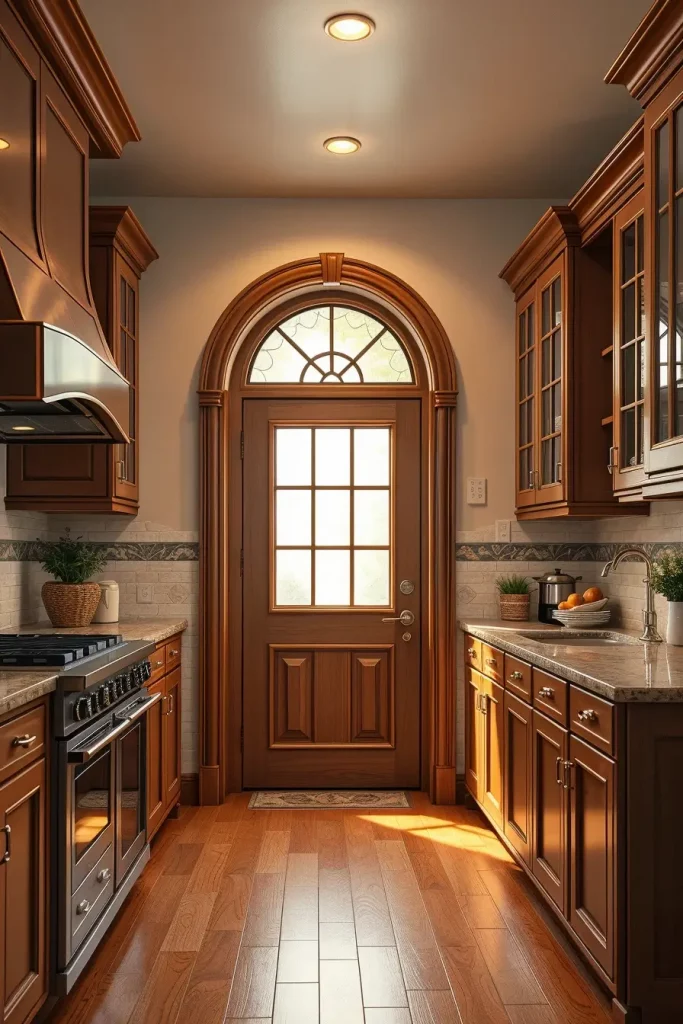
When it comes to my own projects, I have noticed how a simple pantry entrance may be rounded to make even the smallest kitchen look awesome. They make a slight change in the architecture to a more personal, luxurious look without having to do a complete overhaul.
Curvy Breakfast Bars For Casual Dining
A curvy breakfast bar would provide a sense of fun and yet be practical in sitting. The curved shape allows diners to communicate with each other more easily and frequently suits awkward kitchen arrangements better than a straight bar.
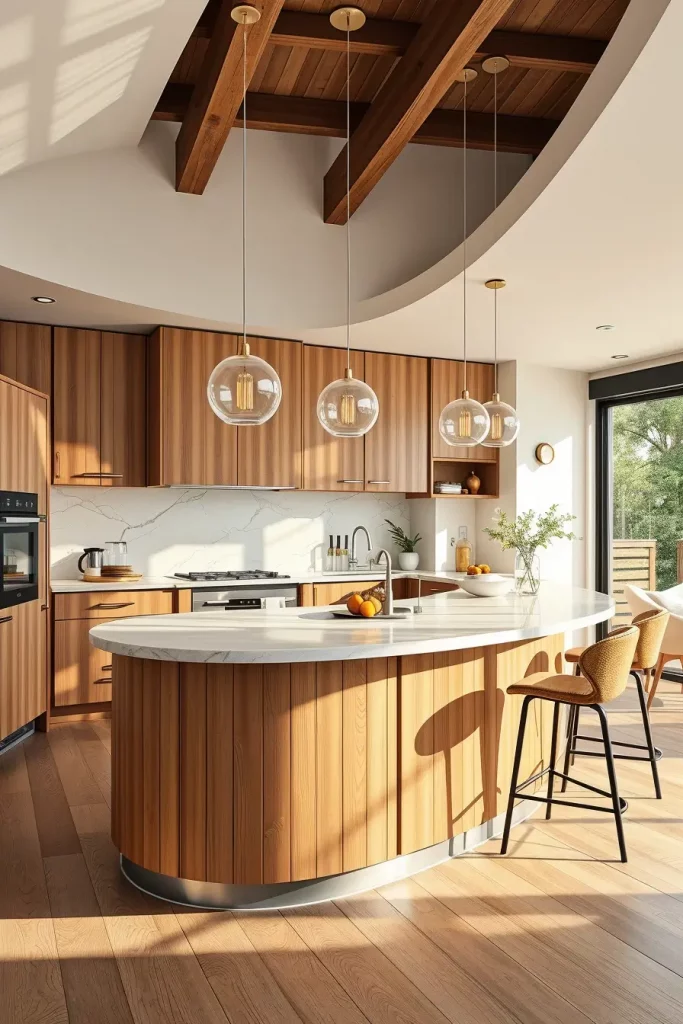
I normally make these bars with a solid quartz or stone top, with a curved wooden or upholstered base. The selection of the stools that follow the curve makes it more comfortable and visually rhythmic. The bar may also be included in a bigger island or may be used as an independent element in smaller kitchens.
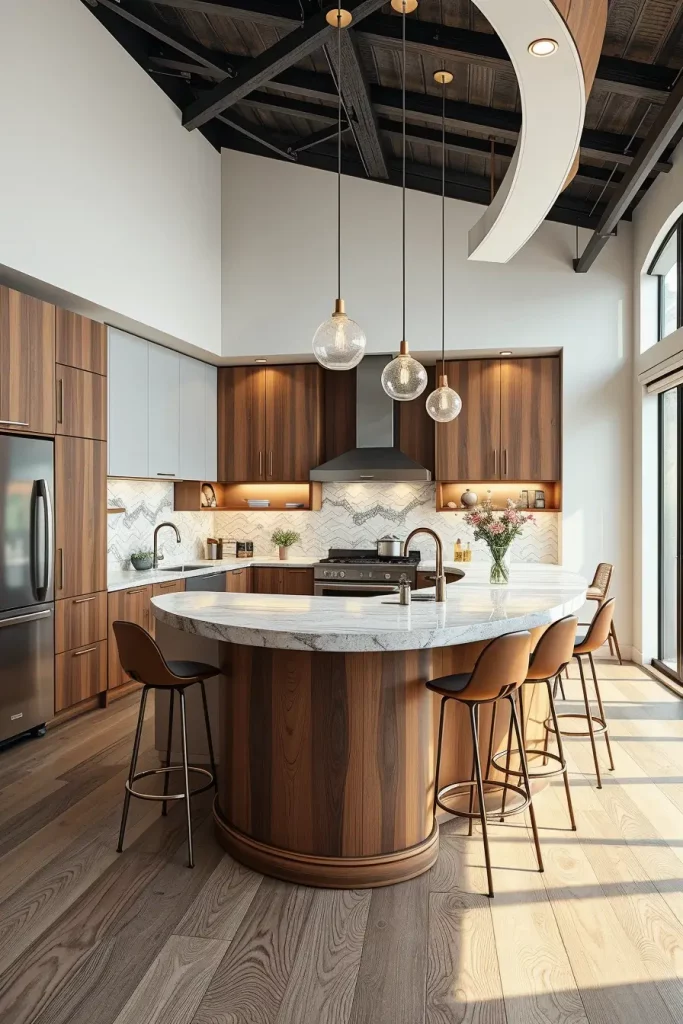
Personally, I find that curvy breakfast bars promote everyday use- whether it is a fast morning coffee to a casual evening snack. They combine a social purpose and design style, which is why I use them as one of my recommendations to customers who want a more feminine kitchen.
Wave-Edged Open Shelves
Wave-edged shelving also adds movement to a kitchen design, interrupting the linearity of the cabinetry. The flowing edge detail is lovely to show off decorative pieces or normal dishware, and makes the shelves look handmade.
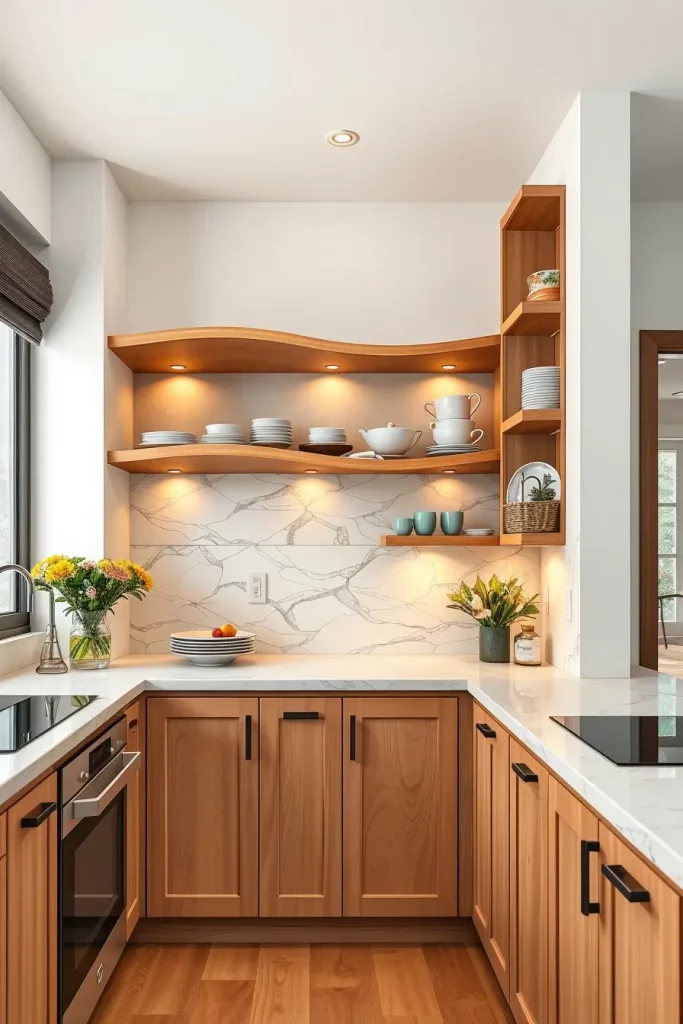
I like to make these shelves out of solid wood, with the grain of the wood completing the organic form. They may be left natural to give a warm earthy appearance or painted to match or contrast with the cabinetry. The special contours can be accentuated by the addition of under-shelf lighting.
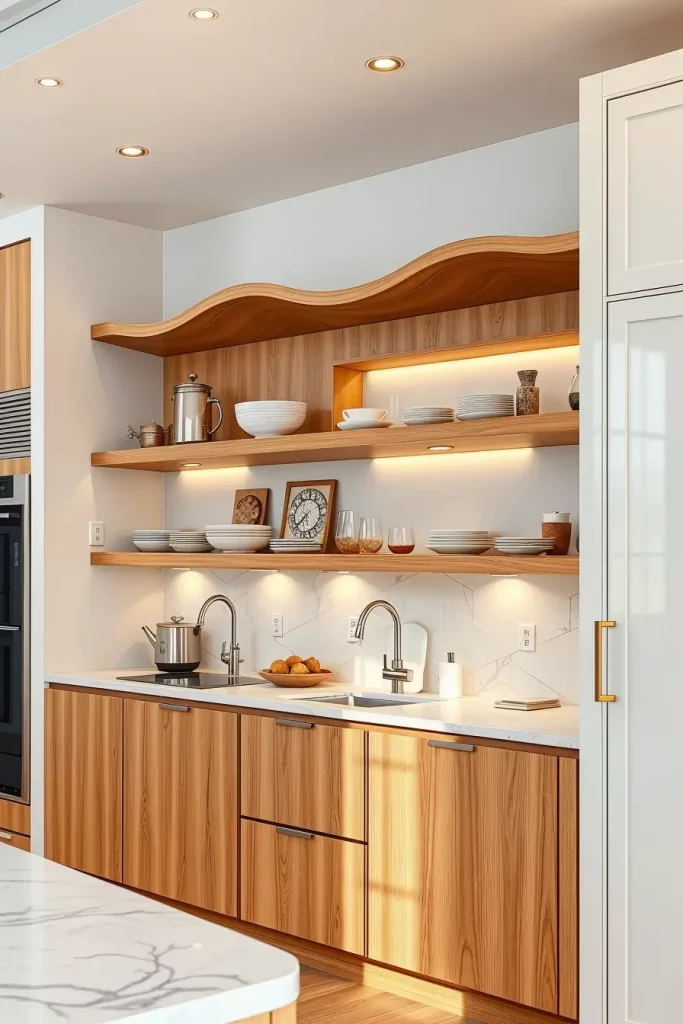
To me as a professional, wave-edged shelves may be a discreet but unforgettable design element. They add some artistry to practical storage, and fit right in with the move toward customized kitchens.
Arched Cabinet Glass Panels
Cabinet doors with arched glass panels are both elegant and transparent. The glass panel curve softens the cabinetry appearance and gives a glimpse of well-organized contents inside. This is especially effective with upper cabinets where you would like to showcase glassware or fine china.
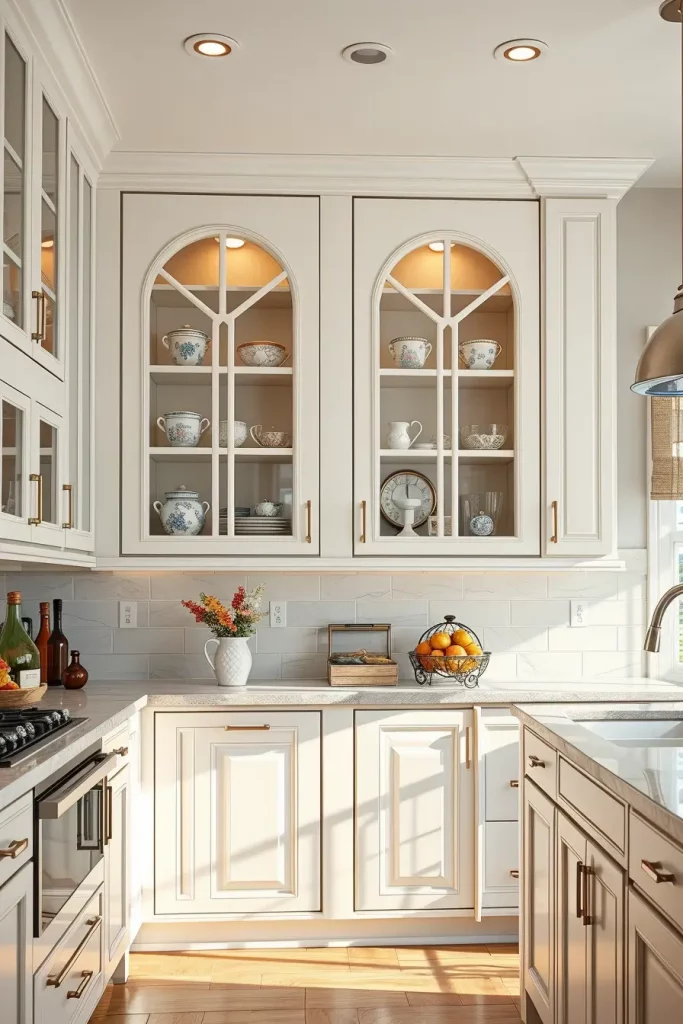
I frequently combine these panels with mullions which are carried along the arch, giving a fine architectural touch. It is possible to make a choice of frosted or textured glass to have some privacy and still enjoy the beauty of the shape. It is important to match the cabinet finish with the millwork around it so that the design does not appear accidental.
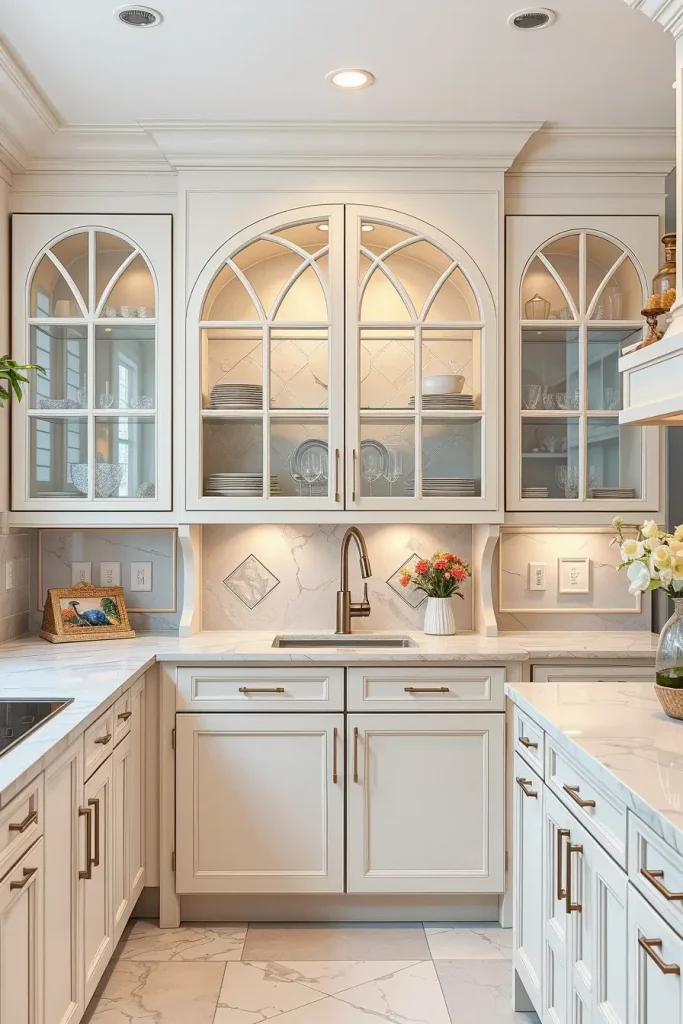
In my experience, arched cabinet glass panels are a slight reference to the old school craftsmanship, but they are also perfectly suited to modern designs. They make the cabinetry lighter and assist in breaking up a wall of solid doors.
Rounded Marble Or Quartz Counter Ends
I like rounded marble or quartz counter edges that give a kitchen a softness that traditional sharp counter edges lack. These rounded ends do not only make the visual flow better, but they also make it safer, especially in a busy kitchen in a family. The rounded corner of the counter eliminates the possibility of bumps and bruises, so it is as functional as it is fashionable. These soft shapes serve to make the kitchen fit well with other living or dining rooms in open-concept kitchens.
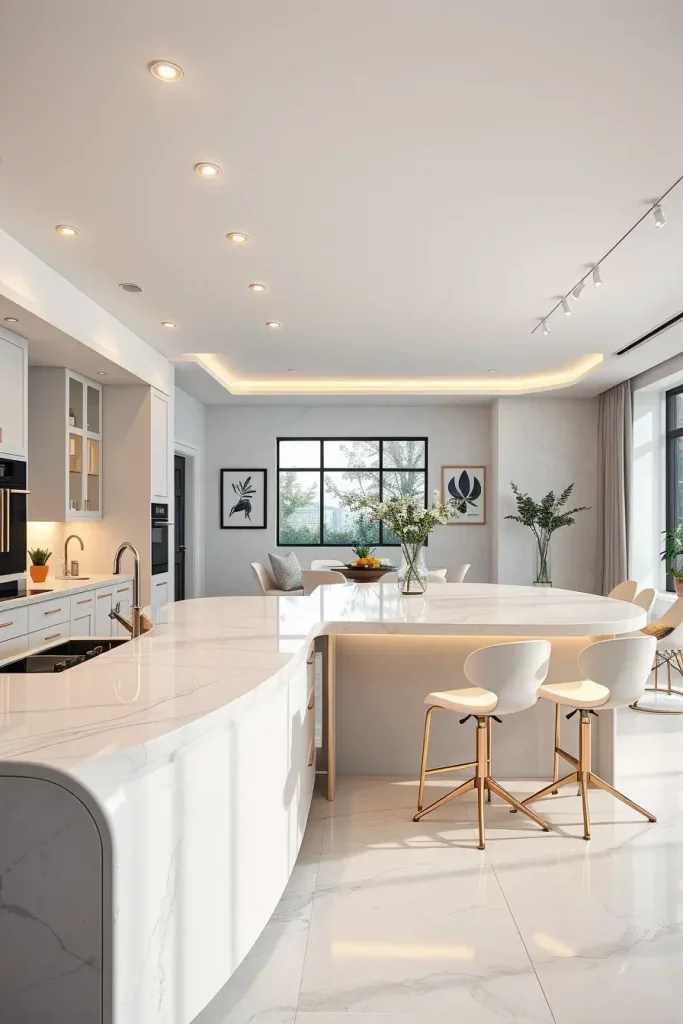
I prefer to use high-quality marble or quartz when I am choosing the materials as it will be durable, luxurious, and timeless. I tend to combine a rounded island end with slick bar stools that have the same curves in the seat design to make the whole design cohesive. The curvature is further accentuated by soft LED lights under the counter creating shadows that create depth in the room.
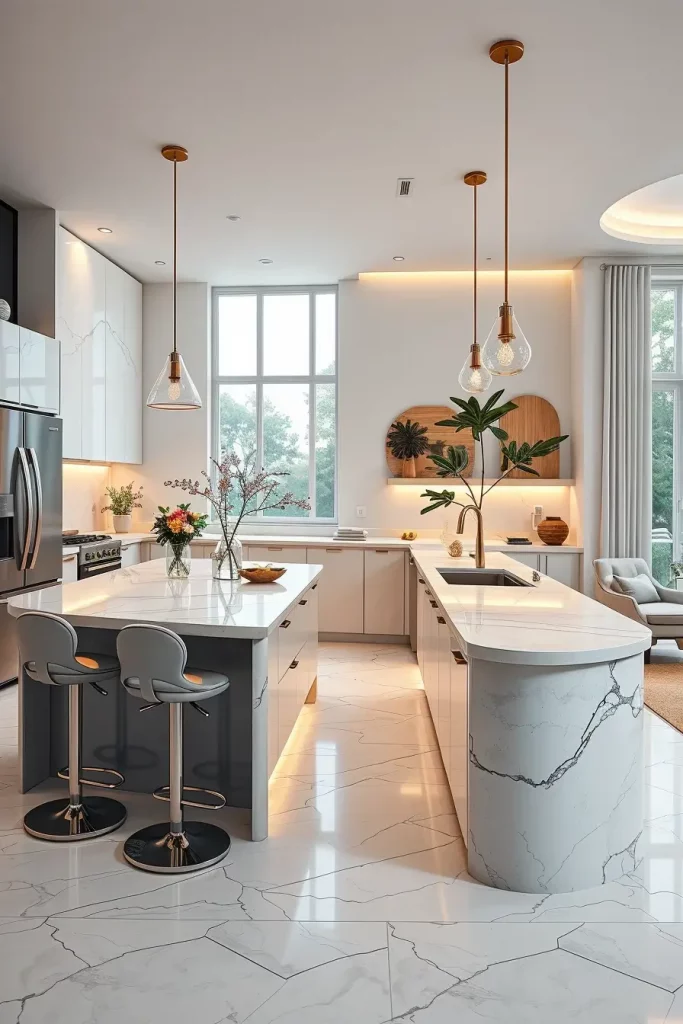
Personally, I have heard clients say that they feel less boxed in and more welcoming in their kitchens with these rounded counters. One of my favorite tips, which I read about in Architectural Digest, is to make the curve of the counter to match with other rounded pieces in the room, e.g. light fixtures, cabinet handles, etc. to make the design harmonious.
In the event that I were developing this idea further I would include some slight veining in the stone which would naturally follow the curve. This minor detail gives the surface a sense of organics, like the shape grew out of the material.
Soft Spiral Staircases Leading To Kitchen Lofts
Soft spiral staircase can be a lovely architectural feature to the kitchens that open onto lofts. A spiral form has a smaller footprint as opposed to straight stairs, making it ideal in a small home or open floor plan. The curved lines of the staircase provide movement and grace and serve as a natural point of interest in the kitchen without being the center of attention.
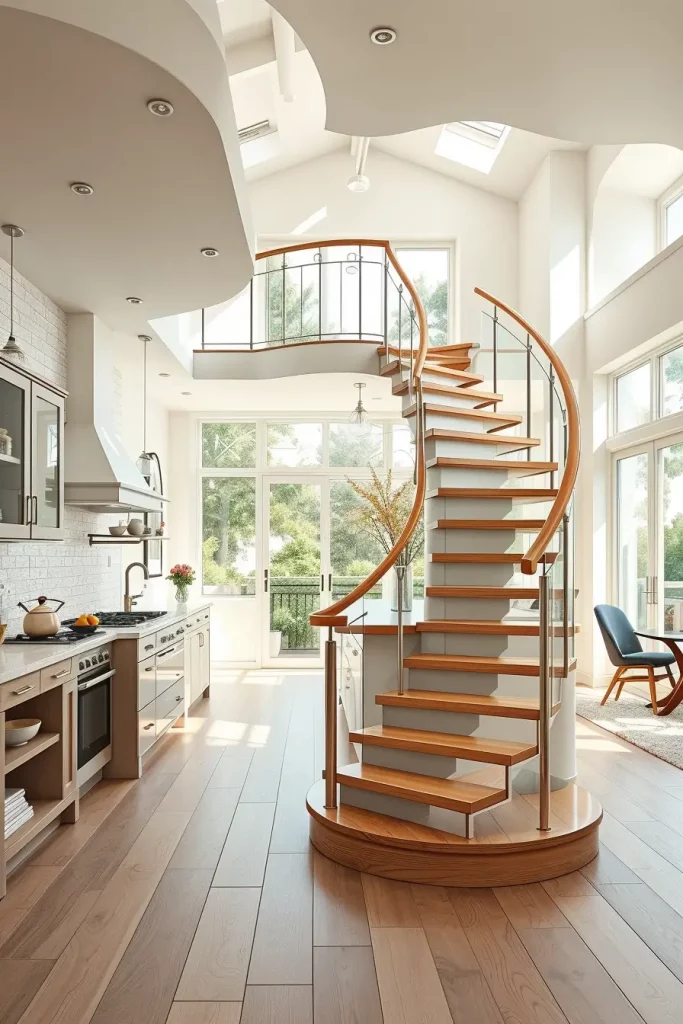
When I specify materials, I tend to suggest the use of wood treads with a metal or glass railing in order to balance the warm and modern feel. The space is made to feel light with a light-colored wood and a rounded handrail to add a tactile experience of going up or down. Locating the staircase close to a kitchen island can be a dramatic visual combination of vertical and horizontal curves.
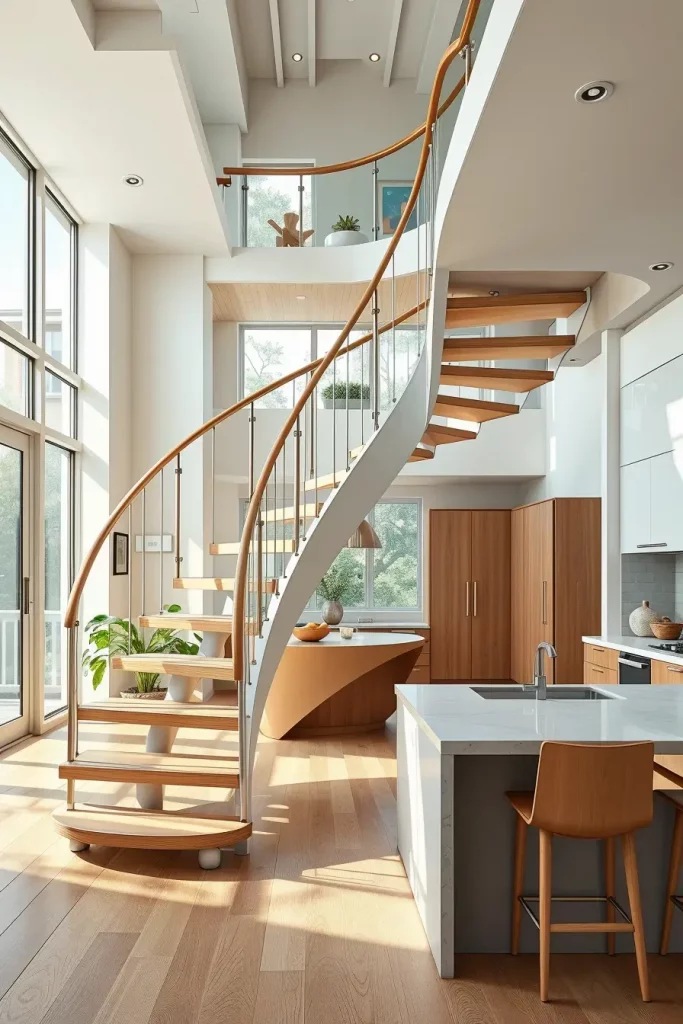
Personally, I like how a spiral staircase can bring the kitchen and the loft close to each other. I have witnessed its application in homes where the loft is a dining or reading nook therefore the transition between the two spaces is a smooth process. One of the features that I have observed in Elle Decor is the use of lighting on the inner curve of the staircase to highlight the shape of the staircase at night.
To finish off this section of the idea, I would incorporate an open riser design on the steps so that the natural light can penetrate through and make the kitchen feel open.
Blending Curves With Natural Materials
Soft curves blended with natural materials such as wood, stone, or clay make a kitchen organic and earthy. The soft lines mellow the hard surfaces that are common in kitchens and the materials add texture and warmth. This mix is especially suitable in the houses that seek a balance between modernity and nature-inspired comfort.
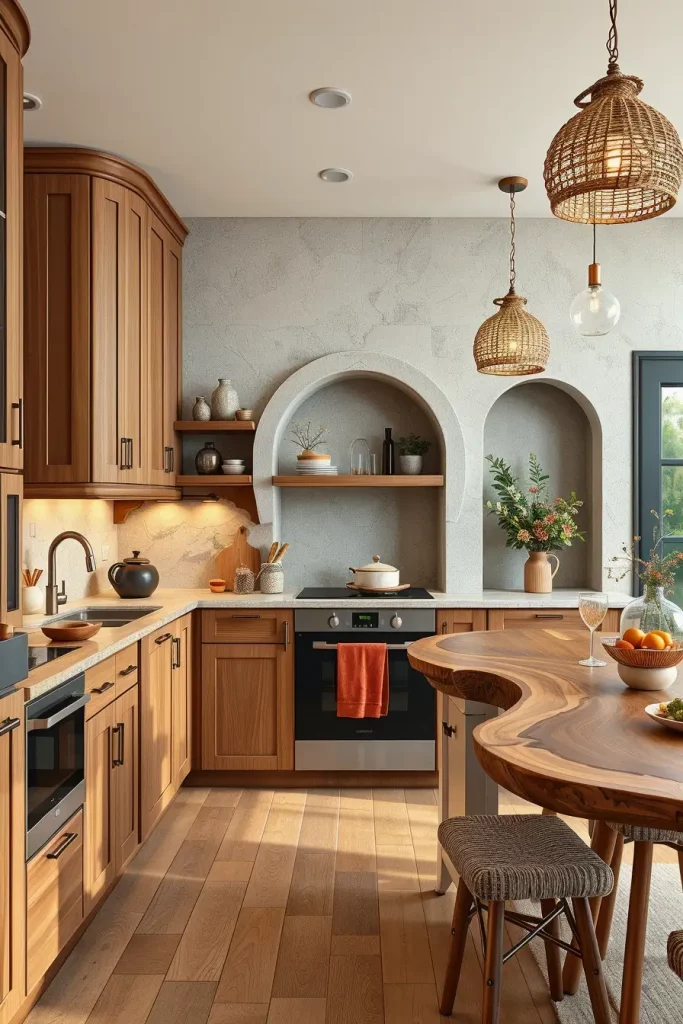
In designing these kitchens I usually suggest rounded wooden cabinet fronts, a stone backsplash with rounded edges, and maybe an arched niche to put shelves in. The furnishing such as round dining tables or wooden curved benches adds to the appearance. The curve theme can also be carried through with even a naturally shaped live-edge wooden countertop.
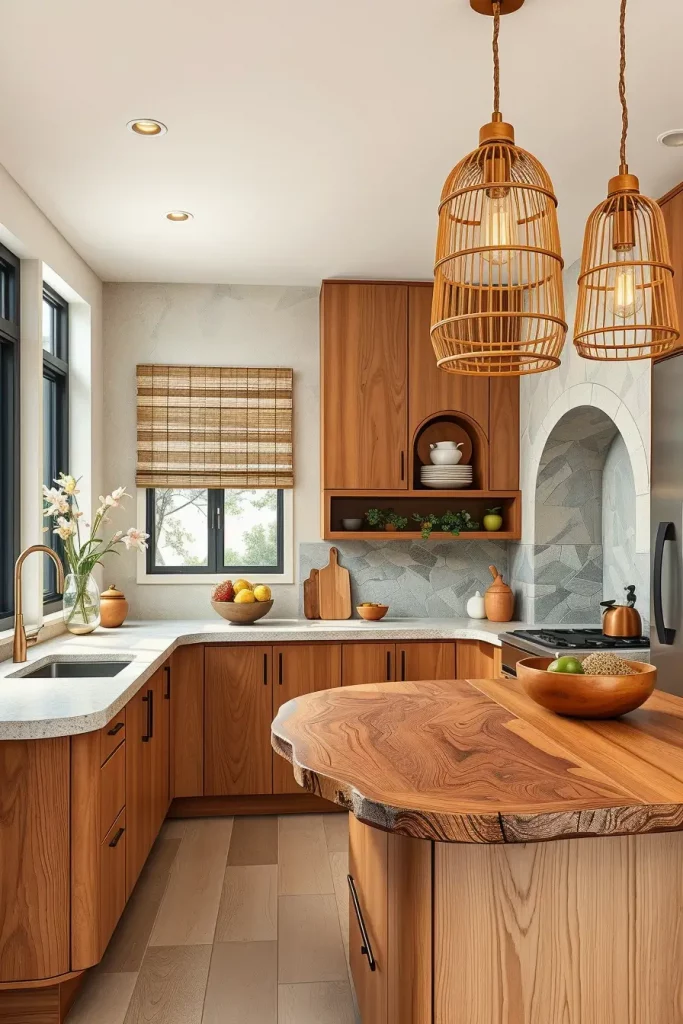
Personally, in my own projects, I have discovered that these design decisions promote a more relaxed, welcoming environment- one that makes cooking and entertaining feel more comfortable. As recommended by House Beautiful, matte or semi-matte finishes can be used to improve the organic nature of natural materials without making them difficult to clean.
In case I wanted to take this a step further, I would incorporate curved lighting fixtures of rattan or woven fibers to have the textures contrast with the smoothness of the countertops and cabinets.
Creating A Flowing Kitchen Design That Lasts
A flowing design in a kitchen makes its style to be timeless. The strategic use of curves gives a sense of movement that is modern and classic at the same time. It is all about striking a balance between the curvature and functionality in a way that the form does not outweigh the purpose.
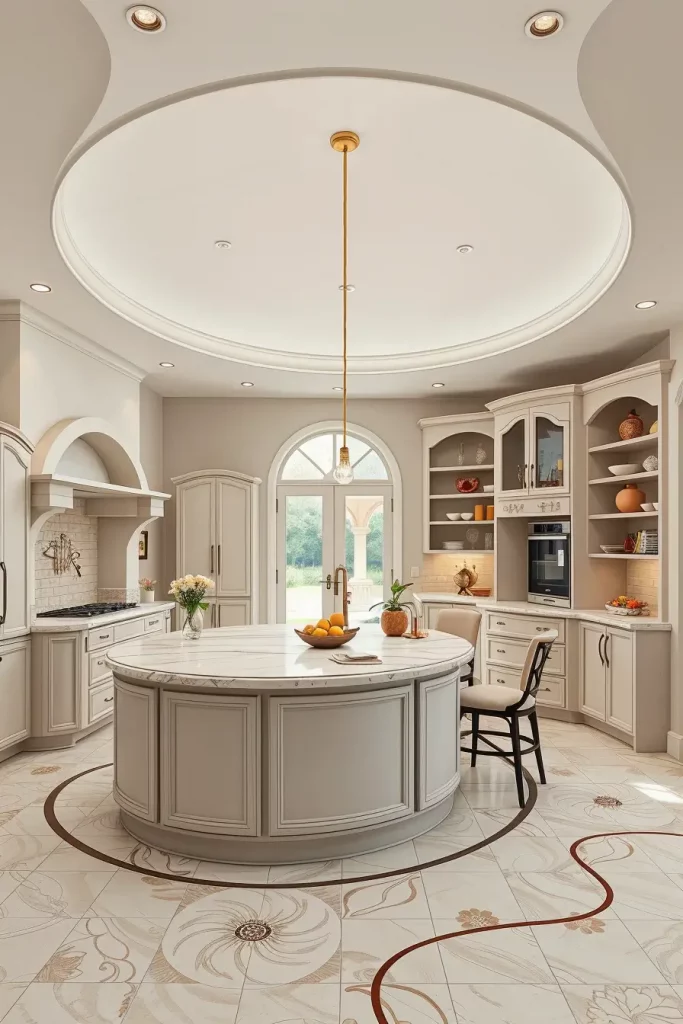
When I design, I may have the arc of a kitchen island follow the curve of a ceiling soffit or the curve of a backsplash follow the slight curve of a breakfast bar. The space can be made to feel coherent by using rounded cabinet corners and slightly curved shelves. The feeling of flow is further supported by adding an arched doorway or pass-through window.
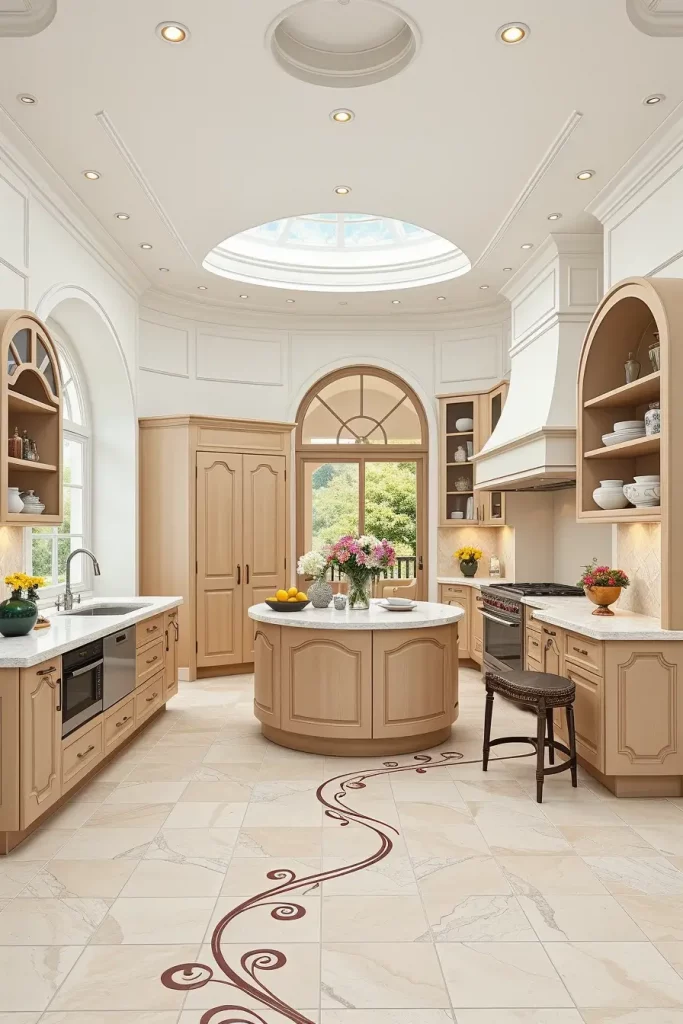
Personally, I have observed how homeowners have valued the manner in which curved layouts direct traffic in the home. Better Homes & Gardens adds that a flowing design minimizes visual clutter, which makes the kitchen simple to navigate and pleasant to use in the long run.
In case I was improving this idea, I would make sure that the flooring pattern also goes with the curves- maybe a curving tile inlay that does not distract the eye too much, but just enough to guide foot traffic.
Kitchen with soft curves is a combination of beauty, comfort and functionality in one single timeless space. By incorporating rounded features into counters, staircases and natural materials, you make a room feel comfortable but sophisticated. The design decisions will not only make the kitchen look better but also increase the flow and safety and make it a place you will enjoy in years to come. How do you feel about putting curves in your kitchen? Share your thoughts in the comments!
